NADEEM GABBANI, FOUNDER OF EXOBOTICS

MANUFACTURING PRODUCTION MAY 2023 ENGINEERING MANUFACTURING PRODUCTION EXHIBITION AUTOMATION UK 20TH-21ST JUNE 2023
INTERVIEW


Editor Paul Attwood editor@mpemagazine.co.uk
Senior Editorial Assistant
Francesca Amato editorial@mpemagazine.co.uk
Features Editor Harry Peters editorial@mpemagazine.co.uk
Production/Design
Laura Whitehead laura@lapthornmedia.co.uk
Sales Manager

Charlotte Chapman charlotte@mpemagazine.co.uk
Sales Executive Alex Costa alex@lapthornmedia.co.uk
Accounts
Richard Lapthorn accounts@mpemagazine.co.uk
Circulation Manager
Leo Phillips subs@mpemagazine.co.uk
Publishing Director Maria Lapthorn maria@lapthornmedia.co.uk
News: Swegon extends its partnership with Volvo Scandinavian Mixed 2023 Energy: Making the energy system smart Exhibition: Automation UK, Coventry Building Society Arena, 20th-21st June 2023


Interview: Nadeem Gabbani, Founder of Exobotics News: New Initiative Equips Teachers for 3D Printing and Scanning


Editors Note
Welcome to
latest
of Manufacturing & Production Engineering Magazine.
We are looking forward to Automation UK, taking place at the Coventry Building Society Arena, 20th-21st June 2023. Automation UK, a new exhibition highlighting the importance of robotics and systems integration to the future growth of the UK economy, is poised to be a sell-out event as the countdown to the show enters its final weeks.
 Paul Attwood Editor
Paul Attwood Editor

In this edition we hear from Nadeem Gabbani, Founder of Exobotics about the creation of the new Department of Science, Innovation and Technology. A fascinating read from Nadeem.
We hope you enjoy this issue and as always, if you have any news that you would like to feature, please email details to editor@mpemagazine.co.uk
Every effort is made to ensure the accuracy and reliability of material published in Manufacturing & Production Engineering Magazine however, the publishers accept no responsibility for the claims or opinions made by advertisers, manufactures or contributors. No part of this publication may be reproduced or transmitted in any form or by any means, mechanical, electronic (including photocopying) or stored in any information retrieval system without the prior consent of the publisher.
03 Manufacturing & Production Engineering Magazine
CONTENTS
Media Ltd
Eurokent Business Park, Ramsgate, Kent, CT12 6PB Tel: 01843 808 117
Lapthorn
5-7 Ozengell Place,
06 14 30 46 50
06 50 30 14 46
the
edition
@mpemaguk mpemagazine.co.uk
Piab Group acquires COVAL
Piab Group has acquired COVAL, a major global player in vacuum automation components and systems. With more than 35 years of history, COVAL adds a solid portfolio of premium products, highly experienced and skilled employees, a strong brand known for the highest quality standards, and many new customers to Piab Group. Through the acquisition, Piab Group is evolving automation by strengthening its position as a world leading automation company.
The transaction is fully funded through a combination of external and internal sources.
“We are very much looking forward to bringing the COVAL team into the Piab family and we see a great culture fit routed in a strong passion for the future of robotics and automation. With this strategic move, we are confident in our ability to provide our customers with cutting-edge automation solutions, while strengthening our competitive advantage in the market”, says Peter Laurin, CEO of Piab Group

“COVAL has a perfect strategic fit for our business. The market for industrial automation is growing rapidly and we foresee very strong growth opportunities with the addition of COVAL’s competitive portfolio and highly skilled employees, whom I would like to take the opportunity to welcome to Piab Group”, says Gustav Falconer, President Vacuum Automation Division.
“Piab Groups long history of innovation in vacuum technology and global presence will allow for COVAL to further develop and provide a long-term home for our family business and its employees. By joining the Piab Group, COVAL joins an excellent global company, a leading innovator in the vacuum technology market and together we will strengthen our leading position in the automation industry”, says Michel Cecchin, Owner and CEO of COVAL
The Alchemy Metals Group announces an integrated waste management division, Alchemy Integrated Waste Solutions
Alchemy Metals, a leading provider of recycling solutions, particularly metal, cable, transformers, and switchgear, is excited to announce the launch of our Integrated Total Waste Management Service. This new service expands our commitment to environmental sustainability and carbon reduction, by providing businesses with a comprehensive managed solution for waste management. With the new division, Alchemy will handle all aspects of waste removal, from the initial waste assessment to environmental, logistics and recycling or disposal. Our aim is to reduce carbon and aim for Zero to Landfill. Our team of experts will work with clients to create a customised waste management plan that meets their specific needs, including waste reduction strategies, recycling solutions and proper disposal methods.
‘By offering an integrated waste management service, we are providing our clients with a one-stop-shop for all their waste management needs’, said Karen Greasby, Operations Director.
‘We believe that our commitment to environmental sustainability is essential to the success of our clients, our business, and our planet. We are excited to help companies take an active role in creating a sustainable future through our comprehensive waste management service’.
The Alchemy Integrated Waste Solution includes:
• Dedicated contract managers no matter the size of the account.
• Waste assessment – our team will assess the client’s current waste management practices to identify opportunities for waste reduction and recycling, at the same time assessing opportunities to increase revenue in their commodity
waste streams. We aim for single grade markets to achieve the best returns.
• Customised waste management plan – we will work with the client to create a tailored waste management plan that meets their specific needs and goals, which may include balers/ compactors etc to reduce volumes and maximise returns.
• Waste Collection – Our team will collect waste on a schedule that meets the client’s needs, ensuring that waste is properly separated for recycling or disposal, as well as providing the relevant equipment for waste to be managed effectively.
• Transportation – We will transport waste to the appropriate recycling or disposal facility, ensuring that all regulations are met.
• Disposal – We will recycle or dispose of all waste in a safe and environmentally responsible manner, ensuring that all waste is properly handled and documented.
By offering an Integrated Waste Disposal Solution, Alchemy is committed to providing businesses with a comprehensive solution for waste management that supports environmental sustainability. We believe that our new service will help our customers achieve their sustainability goals while also contributing to a cleaner, greener planet.
For more information on the Alchemy Integrated Waste Solution, please contact us at waste@alchemymetals.co.uk

Company News 04 Manufacturing & Production Engineering Magazine
Megnajet looks to the future with investment in new appointments and production facilities
Fluid management systems specialist, Megnajet, has its eyes set on a bright future for its products and services with the development of its Kettering production facility and several key promotions.
The production facility is being doubled in size, allowing for the Megnajet team to expand its manufacturing output as the adoption of its customer-focused innovative technology develops.
In addition, several key internal promotions have been made to strengthen Megnajet’s operations and sales teams. Amongst the changes, Adam Eaton has been promoted to the role of Engineering Manager, and Andy Jinks to Site Manager. Both will work alongside Megnajet’s General Manager, Mike Seal, in driving the overall business forward.
The company is also implementing a new ERP system to give a seamless production process from quotation and manufacturing to shipment and invoicing, as well as improving inventory control and shortening delivery lead times for customers.
Mike said: “We have always had a strong reputation for working closely with our partners to develop innovative fluid management systems. The newly defined roles and extended capacity puts us in a position where we can effectively meet growing customer demand for our products.”
Megnajet provides compact, robust, reliable, easy to integrate fluid
management systems to support OEMs, from laboratory testing and initial application through to full production, delivering a faster time to market and reduced development costs.
Demand for its products across a wide range of inkjet and fluid applications continues to grow.
With more than 10 years’ experience in offering a broad range of solutions for all commercially available industrial printheads across a variety of applications, the team at Megnajet focus on providing a ‘one stop’ resource for OEMs.
To complement these investments in staffing and facilities, a new website has been launched, to showcase the unique benefits that Megnajet delivers, as well the full range of products and all its latest news.
Contract Manufacturer Lenalea Electronics Invests in 3D AOI to Drive Productivity
Located in County Armagh, Northern Ireland, contract manufacturer Lenalea Electronics Ltd has been using 2D Automatic Inspection System technology for almost a decade and has now invested in the latest 3D AOI from Europlacer to support its expansion plans.

Just a week before Christmas, the team at Lenalea Electronics received an early festive present in the form of a brand new 3D AOI system delivered by Europlacer on 19th December 2022 directly to its factory in Markethill, Co. Armagh. The new system went straight into production.
Having been delighted with more than eight years of use from its 2D AOI system, and with the business expanding, the Lenelea production engineering team decided to invest
in the latest 3D AOI solution from Europlacer. The objective was to boost productivity by reducing programming time. The latest AOI software enables a much higher level of automatic programming, which reduces operator decisions and consequently reduces false calls. This investment was imperative due to the increasing volume of new customer business coming through the company’s doors.
3D AOI substantially reduces the effects of component shadowing that can sometimes be flagged up as possible errors, requiring an operator to make a fault or no-fault assessment. In addition, 3D technology distinguishes solder on a pad more effectively, providing a greater level of post-reflow assembly confidence.
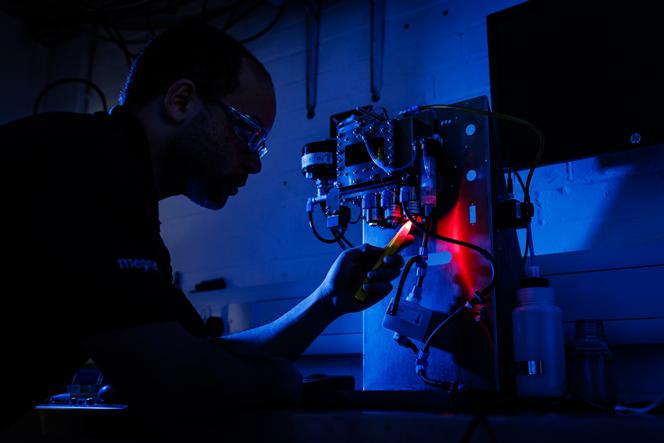
“False calls are now very infrequent,” claims Lenalea director
David Foster. Where potential errors are highlighted, the Lenalea operators benefit from a clearer perspective of the board thanks to a built-in microscope function with next level resolution graphics.
Lenalea wisely involved its assembly operators in the AOI evaluation and purchase decision, with the Europlacer solution favoured due to the company’s multi-award-winning customer support and AOI expertise. “The transition from 2D to 3D proved straightforward thanks to Europlacer’s applications support, with our team getting up to speed quickly,” Foster says.
“We are very pleased with our investment and the new AOI is already making a positive impact on our productivity and helping to drive our expansion.”
05 Manufacturing & Production Engineering Magazine Company News
The transition from 2D to 3D proved straightforward thanks to Europlacer’s applications support, with our team getting up to speed quickly.
Swegon extends its partnership with Volvo Scandinavian Mixed 2023
Andreas Örje Wellstam, CEO Swegon Group: “We look forward to being a partner to Volvo Scandinavian Mixed for the third year. For us, it is important to participate in forums where there is a strong focus on areas that are in line with our own focus areas, such as sustainability and gender equality. Golf is an equal sport which is played on equal terms, and it is a sport that attracts a wide target group. In our work to achieve gender equality and to communicate the value of a good indoor climate for people to feel and perform at their best, Volvo Scandinavian Mixed is a good platform for us to reach out to a wide audience.
“We are very proud to extend our partnership with Swegon to this year’s Volvo Scandinavian Mixed. Swegon is a partner with a strong sustainability and equality focus that fits our brand, events, and core values. The competition and Swegon have a long-term collaboration
where Swegon is an important partner in the work towards a sustainable future. Considering how health and productivity are affected by the indoor climate, we at We Do Sports asked Swegon to measure the indoor climate at our head office in Gothenburg, where we want to ensure a good indoor climate for our employees. Swegon will also measure and visualise the indoor climate at the clubhouse during this year’s golf competition. We are very proud and happy to be able to present our continued partnership with Swegon and are very much looking forward to this year’s edition at Ullna”, says Claes Nilsson, CEO of We Do Sports and initiator of Volvo Scandinavian Mixed.
“We look forward to raising awareness and demonstrating the benefits of a good indoor climate during this year’s competition”, says Andreas Örje Wellstam.

People spend almost 90% of their time indoors, but few are aware of how the indoor climate affects the health and
productivity. Investing in a good indoor climate has several positive benefits, both on the environment since modern indoor climate systems are smart and consume less energy, and on the people spending time inside the building benefitting from improved wellbeing and productivity.
Nulogy Secures $20 Million CAD Funding to Drive Supply Chain Collaboration & Digitisation Solutions

Nulogy, the leading provider of supply chain collaboration solutions, today announced the company has received $20 million CAD (approx. £12 M GBP) in a mix of funding from Export Development Canada (EDC) and incremental working capital from a Tier 1 Canadian Bank. The funds will be used for product innovations and to accelerate the growth of Nulogy’s multi-enterprise supply chain platform and solutions.
Nulogy’s solutions are used by fast moving consumer goods (FMCG) and consumer packaged goods companies
and their networks of contract manufacturing and contract packaging suppliers. The funding from EDC was completed in the first quarter of 2023.
Nulogy’s cloud-based platform provides a set of solutions both for suppliers—including co-packers and contract manufacturers, and for the brands and manufacturers who trust these suppliers to function as an integral part of their business operations. The unique capabilities of the Nulogy solutions enable these companies to collaborate in near real time to monitor and manage orders, to respond to rapidly changing conditions, and to cut costs, increasing the quality and efficiency of their supply chain operations. According to a 2021 report from industry analyst firm Gartner, Nulogy is the only notable vendor for the contract manufacturing and contract packaging industry.
“We’re excited to partner with EDC to continue innovating new capabilities to better serve our customers, while
accelerating the growth of our network of users,” said Jason Tham, CEO and co-founder of Nulogy. “As a provider of multi-enterprise solutions, the larger the number of users of our network, the greater the value for all users—so we’re very excited about the value this brings to our community of customers.”
“Nulogy has been focused on core supply chain solutions, propelling some of the world’s leading brands and their supplier networks in more than 20 countries,” said Guillermo Freire, Senior Vice-President, MidMarket Group at EDC. “EDC is committed to helping Canadian midmarket companies like Nulogy realise their international growth potential. As a strategic partner, EDC can support Nulogy by leveraging our financial solutions, trade knowledge, and global networks, which will provide the company with even more momentum as they expand into new markets around the world.”
Company News 06 Manufacturing & Production Engineering Magazine
Make smarter decisions


Increasing plant availability and performance.
















Endress+Hauser can help optimise your processes to increase plant availability. In our increasingly demanding industry the need for results-based outcomes, changes in regulations and advances in technology necessitate a move from reactive to predictive maintenance. From developing a clear picture of your installed base to obsolescence plans, and from digital solutions to bespoke calibration service agreements, we can help you succeed today and in the future.





Find out more at: smarter-decisions.co.uk
Selective Soldering: A Need for Innovation and Development
Samuel J.
McMaster*1, Andrew Cobley1, John E. Graves1, Nigel Monk2
Introduction
Selective soldering utilises a nozzle to apply solder to components on the underside of printed circuit boards (PCBs). This nozzle can be moved to either perform dips (depositing solder to a single component) or draws (applying solder to several components in a single movement). The selective soldering methodology thereby allows the process to be tailored to specific joints and allows multiple nozzle types to be used if required on the circuit board.
Nozzles can vary by size (internal diameter) and shape (making them suitable for different process types). This is all dictated by board design and process requirements. Selection of the nozzle type is dependent upon the product to be soldered and the desired cycle time. Examples of different nozzle types are shown here
Hand-load selective systems must be programmed with the parameters for multiple solder joints. However, many inline systems are designed to be modular. This modularity allows for multiple solder stations with different conditions/nozzles to achieve low cycle times. Figure 1 shows the two distinct types of selective soldering systems offered by Pillarhouse International Ltd.
Selective soldering provides many other benefits compared to wave and hand soldering such as:
• Minimal thermal shock.
• Lower running costs than wave soldering.
• Operation under an inert environment to minimise soldering defects, reduce the production of dross and improve wetting performance (more details below).

• Applicability to low and high-volume production.
• Repeatability in the process and solder joints.
• Fewer operators required.
Key attributes of nozzles
To ensure that controlled application of the solder is maintained throughout the process, the solder must wet (adhere) to the nozzle. Wettability is the study of the adhesion of liquids to solids because of the interaction between the surface energy of the solid and the surface tension of the liquid. Surface energy (known as surface tension when referring to liquids) is a result of the relative bond strength of the material and the level of unbalanced forces at the surface. Multiple methods exist to characterise surface energy depending upon the components of the surface interaction that can be measured however the most common is measuring the contact angle of a stationary (sessile) droplet.
When no other forces act upon a liquid droplet (i.e., no contact with other surfaces and no air resistance due to
movement), it will form a sphere as its own surface tension pulls it into that shape as it is the minimum energy shape it can be. When in contact with a solid, the droplet will deform and spread out. The amount of spreading and the angle of the interface between the liquid and solid is a product of the relation between the surface tension of the liquid and the surface energy of the solid. Figure 2 demonstrates scenarios with various levels of wetting. When the surface energy of the solid is greater than the surface tension of the liquid, the droplet will spread out more and have a lower contact angle. Figure 2(a) and (b) are an example of this.
Typically, a static system would be preferred for wettability studies, but we are dealing with a dynamic process in the case of a nozzle. In this instance, the wetting of the solder to the tip of the nozzle maintains a stable radial wave and achieves control during the soldering process by maintaining a stable dome shape to deposit solder.
Figure 3 shows a well wetted nozzle wherein the solder is adhered to the entire outer surface of the nozzle and therefore has a stable radial wave. This allows for good control during the selective soldering process. The static wettability for this nozzle would be akin to Figure 2 (a) or (b).
In the case of a material that solder does not readily wet to (non-wetting), the
LEFT: Figure
1. Examples of different Pillarhouse International selective soldering systems: (a) Jade MKII hand-load system.
(b) Orissa Synchrodex Pro modular inline system.

08 Manufacturing & Production Engineering Magazine
(a) (b)
surface energy of the nozzle (or other material being wetted) is not enough to overcome the surface energy of the solder and therefore the solder will maintain a single stream as shown in Figure 4. The static wettability of this nozzle would produce a large contact angle such as in Figure 2 (c).

For wetting between the liquid solder and the nozzle, there must be a clean interface with minimal surface oxides on the nozzle. The presence of oxides on the surface interferes with the wetting of the solder to the surface by acting as a barrier; additionally, the surface energy of oxides is too low for wetting to occur. Flux is used to remove oxides and generate/maintain this clean interface before and during operation. After cleaning, a chemical reaction between the solder and nozzle determines the extent of the wetting but this interaction also limits the lifetime of the nozzle. It causes wear of the nozzle and metal is leached into the solder bath. Exposure to the solder and the subsequent reaction alone does not cause significant wear. The contribution of liquid flow increases the wear in a synergistic effect which suggests that the underlying mechanism is complex corrosion-erosion.
Therefore, a good nozzle must have good wettability to solder ensuring that
control can be maintained during the selective soldering process in addition to a balance between the corrosion and wetting. The composition must be chosen carefully in materials to achieve this. For example, extremely wettable materials such as copper have a high dissolution rate and will therefore be completely leached into the bath within hours demonstrating the link between the wear process and wetting.
The need for development
Currently, the selective soldering industry sees innovation with the production of new machines, pump types and nozzle cleaning however, there has been only minor development in the study of materials for nozzles. A new nozzle material will reduce operation and maintenance costs for manufacturers by reducing the number of nozzles required overall and reducing downtime caused by nozzle failure. Improving the wettability of nozzles will allow for more challenging joints to be tackled using the selective method. The current nozzles have a lifetime of approximately 200 hours (smaller nozzles wear faster however as they are smaller). This project has been undertaken due to customer requests to increase nozzle lifetime and reduce the maintenance required.
LEFT: Figure 2. Examples of different contact angles between a droplet (stripped red) and solid (blue): (a) Contact angle of 0° demonstrating perfect wetting. (b) Contact angle less than 90°for a wetting surface. (c) Contact angle greater than 90° hydrophobic surface. By Idris.abk - Own work, CC BY-SA 4.0, https://commons.wikimedia.org/w/ index.php?curid=97191171
Other players in the selective soldering industry have developed new nozzles with similar structures based on commonly applied electroless nickelimmersion gold coatings but this approach has utilised materials that are already known to work in the industry. It is well known that the electronics industry is conservative in many regards and rightly so; “why fix what isn’t broken” especially when reliability is paramount. There has been a distinct lack of research in nozzle development. Each selective soldering manufacturer is highly secretive surrounding the materials used for their nozzles but there has been some noted development in nitriding as a surface engineering technique to extend the lifespan of wave soldering apparatus.
This ground-breaking research project, part funded by Innovate UK and Pillarhouse International Ltd. is partnered with Coventry University through a knowledge transfer partnership scheme. The aim is to develop a new, longerlasting nozzle with excellent wetting properties. By applying the studies of tribology and materials science, fundamental work looking at different materials and surface engineering techniques has selected a number of potential candidates that show improved performance.
Prototype testing has been used to confirm compatibility with existing solders and fluxes. The new AP Master Nozzle will be available in June of 2023.


ABOUT THIS ARTICLE:
* Corresponding author –s.mcmaster@pillarhouse.co.uk
1 Functional Materials and Chemistry Research Group, Research Centre for Manufacturing and Materials, Institute of Clean Growth and Future Mobility, Coventry University, Priory Street, Coventry CV1 5FB, U.K.
2 Pillarhouse International Ltd., Rodney Way, Chelmsford, CM1 3BY, U.K.
09 Manufacturing & Production Engineering Magazine
BELOW: Figure 4. An example of a non-wetting nozzle.
BELOW: Figure 3. An example of a wetted nozzle.
Lancashire based Walker Engineering strengthens senior team, with the appointment of new experienced Contracts Manager
Continuing its growth throughout the UK, mechanical and fabrication experts Walker Engineering has announced the appointment of new experienced contracts manager, Ian Brown, growing its total headcount to 26 in the process.

With almost five decades worth of experience in the sector, Ian has previously worked for a host of wellestablished firms throughout the North West, with his latest role coming at Cheshire-based DRB Group between June 2015 and January 2023.
With his contract management experience dating back as far as 1999, the highly skilled engineers role at Walker Engineering will now focus on everything from client management, the estimation and procurement of materials and the leadership of on site teams to ensure that client projects are delivered in a timely manner.
Andy Walker, managing director, Walker Engineering, said: “As a family business, the success of the company must always be accredited to the hard work, dedication and determination of our team. Ian’s extensive experience of working with people, whether that be staff members or clients is second to none and I have no doubt that he will play a pivotal role in helping us deliver and win plenty more contracts and projects across the UK in 2023 and beyond.”
Ian Brown, contracts manager, Walker Engineering, added: “Walker Engineering has a long and proud reputation in the industry, especially in the North West. They are a company that is on a real upward trajectory and I am looking forward to working with Andy and the rest of the team to continue to provide exemplary service for our clients both new and old.”
Invar Group appoints Dan Migliozzi to head up sales in UK and Europe
Invar Group, the leading independent software developer and integrator of advanced warehouse automation, has appointed seasoned business development and project implementation specialist, Dan Migliozzi, to the role of Head of Sales. He will take responsibility for leading Invar Group’s Sales and Solution Design functions in both the UK and Europe.
Dan brings with him nearly 10 years of sales and management experience in the automation industry. He has managed both national and international projects for a number of tier 1, bluechip organisations, consistently delivering projects on-time, in-full and within budget.
Commenting on his appointment, Dan Migliozzi, says: “This is an exciting time to be
Configit Appoints Damantha Boteju as Chief Product and Technology Officer
Configit, the global leader in Configuration Lifecycle Management (CLM), today announced that Damantha Boteju has been appointed as Chief Product and Technology officer. In this role, he’ll be responsible for overseeing the company’s product development strategy.
Prior to joining Configit, Damantha was chief technology officer at Forecast, a scale-up creating the next generation of project management software using AI to boost the success of projects. He also served as Chief Product and Technology officer at Edlund, a leading Scandinavian provider of life insurance and pension software.

involved in warehouse automation and robotics. Many new, innovative technologies are becoming available that can transform warehouse operations, providing the flexibility and scalability that businesses are looking for when faced with capacity and labour resource issues.” He adds: “I’m excited to be part of Invar Group’s management team and to be working with clients on delivering best-practice solutions.”
Craig Whitehouse, Managing Director of Invar Group, says: “Our industry needs highly competent individuals with the skills and drive to realise complex warehouse automation projects, and so, we are delighted to welcome Dan to our management team, we have every confidence in his ability to deliver.”
More information on Invar Group: www.invargroup.com
Damantha is joining Configit as the company continues to improve and evolve its CLM offerings to help customers navigate increasing complexity. His appointment expands Configit’s leadership in the Configuration Lifecycle Management space to meet the rising requirements of complex configurable products and support a rapidly growing customer base.
Johan Salenstedt, CEO, Configit, said: “Damantha brings a wealth of experience to lead Configit’s product strategy. His expertise will ensure we’re giving our customers best-inclass service and enabling them to sharpen their competitive edge by aligning all systems and business processes for true, accurate and complete configurations.”
Damantha Boteju, CPTO, Configit, said: “Configit solves a very complicated problem in the manufacturing space in a truly innovative way. I’m committed to seeing that Configit’s solutions allow all products to be tailored exactly to fit the needs of any customer. We are making a global impact on the product configuration market.”
People On The Move 10 Manufacturing & Production Engineering Magazine
World Leaders in Selective Soldering
Surface engineered for longer life and increased wettability
Benets of the AP (All Purpose) Master Nozzle include...

•
Improved initial wetting for faster nozzle start-up and more user friendly operation

Innovative surface treatment improves long-term wetting
• Lifetime predicted to be at least 8x longer than standard AP Nozzle
• Surface treatment resists oxidation at high temperatures allowing for easier nozzle rewetting


• Improved pull-off performance enables soldering of ne-pitch components
• Compatible with all current solders and uxes
• Compatible with current Pillarhouse nozzle mounting system
•
• Exclusively available on all Pillarhouse machines using wettable nozzles

Pillarhouse International Ltd. www.pillarhouse.co.uk Rodney Way, Widford, Chelmsford, Essex CM1 3BY UK Tel: +44 (0) 1245 491333 Email: sales@pillarhouse.co.uk Pillarhouse USA, Inc. www.pillarhouseusa.com 201 Lively Blvd, Elk Grove Village, IL 60007 USA Tel: +1 847 593 9080 Email: sales@pillarhouseusa.com Pillarhouse (Suzhou) Soldering Systems Co., Ltd. www.pillarhouse.cn 105 Weixi Road, Suzhou Industrial Park, China 215127 Tel: +86 512 6586 0460 Email: sales@pillarhouse.cn
Coming June 2023
Micrometric Celebrates 40 Years of Laser Material Processing
Lincoln-based manufacturing firm Micrometric is continuing to lead the way in micro laser manufacturing and multi-process services during its 40th year of business.


With this special anniversary, Micrometric is reflecting on the evolution of services it provides in a range of sectors including medical, aerospace and automotive. Micrometric began by cutting sheet metal using CO2 lasers in January 1983 and had a turnover of only £50 in its first month but this soon started growing.


Neil Main, Managing Director of Micrometric, remembers contracts that changed the services provided by Micrometric: “We were asked by the Atomic Energy Research Establishment at Harwell if we could make radiation sensors for detecting alpha radiation. They needed small rectangles cutting with each having a unique letter, number and error code. At that time our competitors were not able to do this, so we rose to the challenge and successfully output the parts using the large CO2 laser (DE) and BBC Micro.”
By 1990, Micrometric was a precision laser processor, and several industries
were asking them to make parts: gas turbines, food manufacturers and medical. Most medical items were for instrumentation but Micrometric was asked to make one part for a prostate cancer remover.
In 1994 the company moved into a new purpose-built factory on Doddington Road, Lincoln. With more space Micrometric invested in new hi-tech lasers including its first Bystronic which was fast, flexible and precise.
After Neil purchased Micrometric in 2004, he faced a great challenge: their biggest customer bought its own laser. Company revenue declined, and it resulted in redundancies.
Recovery took a while before Micrometric was able to invest in new equipment. However, technological advances meant that new lasers were state-of-the-art and Micrometric was able to produce better quality components more quickly with a higherskilled workforce.
Over the past five years, Micrometric has invested £1.5m in new equipment to meet demand for precision components, including the Coherent Starcut tube cutting machine which works with extremely high precision, and a new Lasercube machine which delivers on quality and efficiency. These developments will allow the team to continue producing high-quality components for multiple industries.
When looking forward Neil is positive: “We have seen so much change in just the last three years, but customers are still asking for new parts and processes. We are always looking for new ways of expanding our services so there is huge potential for growth.”
Micrometric are AS9100 accredited and are members of the Midlands Aerospace Alliance (MAA), The Manufacturers’ Organisation (MAKE UK), Association of Industrial Laser Users (AILU), The Welding Institute (TWI) and Motorsport Industry Association (MIA).
12 Manufacturing & Production Engineering Magazine
& Machinery
Machines
Find out more about Micrometric on the website or call on 01522 509999.
We are always looking for new ways of expanding our services so there is huge potential for growth.
Neil Main, Managing Director of
Micrometric
LEFT: Left to right, Chris Waters (Commercial Director), Rosie de Smit (Finance Director) and Neil Main (Managing Director)

Making the energy system smart
The role of ASICs in smart grid deployment

In October 2022, the European Union (EU) adopted its action plan to digitalise the energy system for a more efficient, sustainable, secure and competitive energy market. Making its goals a reality requires the use of new digital technologies to make every process smarter — from generation to usage. Here, Richard Mount, Director of Sales at ASIC design and supply company Swindon Silicon Systems, explains the technology required to make energy systems smart.
One of the key actions outlined in the EU’s plan is to help consumers gain more control over their energy usage and bills. To do this, the EU plans to encourage the adoption of smart digital solutions to provide information to consumers to enable them to reduce their consumption or use energy in a more cost-effective way. But it’s not just about cost.
The plan also seeks to boost the proportion of renewable energy for a more sustainable, and resilient, energy market. So, what technology is required to achieve these goals?
Smartening up
The answer lies in Internet of Things (IoT) devices. Digital tools are already used in many aspects of the energy industry — from smart sensors that generate data to enable remote control of solar photovoltaic (PV) farms to smart thermostats that adapt energy usage to meet a predefined ambient temperature in homes. But the potential of digital tools is much more than their current applications.
It’s all well and good having these digital technologies in place, but currently some operate in silo. An interconnected system is the key to enabling maximum efficiency. To do this, the EU has decided to make a digital twin of its nations’ entire energy system, which acts as a virtual model of the physical grid. With sensors placed across every layer, it won’t just be possible to collect data, but also use it to make data-informed decisions.
This is particularly valuable in the increasingly renewable system, as energy production relies on weather conditions. Sharing data across the entire energy value chain can be linked with weather models that predict how much renewable energy can be produced, whether it is enough to meet demand or is surplus to requirements.
But to ensure this data collection, there needs to be a digital electricity infrastructure in place with the technology required to generate data. The electricity grid needs to be able to interact with the devices on its network to bring in data from every source.
This lies in the use of smart sensors to convert analogue data about the environment — on a smart grid this is typically monitoring bidirectional flows of energy to confirm status and determine usage.
With clear insights at hand into how much energy is being used, where it’s being used and for what, the data can be run through AI algorithms. This enables the development of historic trends and the ability to identify areas where consumption is high, areas where supply doesn’t meet demand, and any other trends that can reveal areas where the network could run more efficiently.
Sensor selection
To make sure the signal is in a format that can be received by the system, it needs to be conditioned and digitalised through the use of integrated circuits (ICs). While offthe-shelf ICs do exist, a superior, optimised alternative is an application specific IC or ASIC.
An ASIC is a custom device designed specifically for an application, where the ASIC design team invests in the performance of the chip to ensure it is specifically suited to its particular application. As an ASIC design and supply leader, Swindon is able to optimise the entire signal path down to the finest detail, removing unnecessary features and integrating as much of the optimised circuitry into a single package as possible.
With the reduced component count comes higher reliability, reduced power consumption and greater protection from the environment. In applications like smart grids, where ASICs are deployed to remote locations, this environmental protection is of the utmost importance.
A smart grid is designed to last, so its components must last too. If opting for off-the-shelf ICs, obsolescence is a concern as their manufacture will inevitably cease. However, ASICs are designed with non-obsolescence in mind. ASIC design companies such as Swindon will usually guarantee that the device will be available until the customer halts its production, to overcome obsolescence.
With energy costs mounting and sustainability importance growing, it’s absolutely vital for initiatives like the EU’s digital energy system to succeed. Selecting components that provide the longevity and performance to ensure the system’s functions is key to long-term success.
Energy 14 Manufacturing & Production Engineering Magazine
With clear insights at hand into how much energy is being used, where it’s being used and for what, the data can be run through AI algorithms.


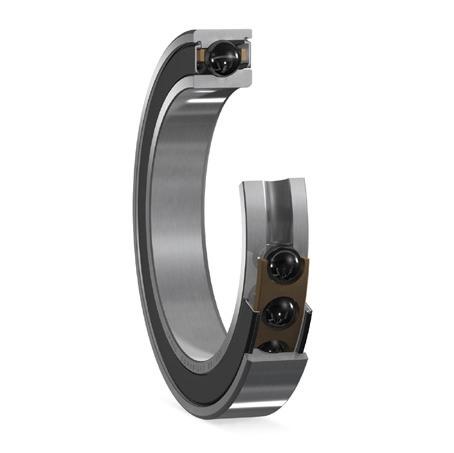


Same-Day Despatch on SKF Super Precision Bearings SKF High Capacity D Design Super Precision Bearing SKF Hybrid Super Precision Bearing with Ceramic Balls SKF Cylindrical Roller Super Precision Bearing SKF High Speed Hybrid and Sealed Precision Bearing SKF Super Precision Bearing Partner T: 0800 8766 441 E: enquiries@acorn-ind.co.uk W: www.acorn-ind.co.uk Supply. Support. Solutions.
Exposing the truth about energy in compressed air systems


Looking back to 2021, it was easy to consider Compressed air as something of a ‘free’ resource. Energy prices were low and manufacturers generating compressed air for one area of their factory could utilise it in another area for next to zero marginal cost. However, since energy prices began their upwards journey, compressed air is no longer the cheap commodity it once used to be.
In 2022, the British Compressed Air Society (BCAS) conducted research into the extent of compressed air use in UK industry. They found that 70% of UK industry uses compressed air in some form or another and that on average, 30% of a business’s entire energy costs could be attributed to compressed air generation.
Using figures from the (then recent) UK Energy-related products policy study, conducted by ICF in May 2021, they calculated the combined energy usage for the mid-point of all industrial compressor technologies over their lifetime at 11.71 TWh. Based on the current UK average non-domestic electrical unit cost of 12.49p/kWh at the time, the figures were substantialequating to £1.475 billion being spent by UK companies to generate the compressed air their businesses rely on.
Add to this the fact that on average 32.9 per cent of this energy was being wasted through leaks and inefficient practices - equivalent to £485.43 million in wasted electricity spend - and we began to understand the extent of which this presents a problem for UK manufacturing.
published figures as a starting point and adjust the BCAS research for todays prices, we find that £2.943 billion is being
have been outweighed by the cost of fixing leaks, thanks to the latest energy prices, the return on investment to combat inefficiencies is now months, not years. Not to mention the opportunity to reduce carbon emissions by up to 3.2 tons per year - A consideration that companies can’t help but be aware of.
With all things considered, isn’t it time your company found out what is happening behind closed doors?

For more information: www.thorite.co.uk

16 Manufacturing & Production Engineering Magazine
Energy
Industry veterans Thorite recently launched their ‘Behind Closed Doors’ campaign, urging businesses to gain a better insight into what their compressors are actually doing for them.
SAVINGS
As energy prices continue to rise, can your business afford not to know how much compressed air your system is wasting? Isn't it time you found out what happens behind closed doors?

Automating Energy Saving





Festo’s combination of a field bus node, flow and pressure sensor, proportional pressure regulator and stop valve in one intelligent service unit component. Integrated


www.thorite.co.uk Visit our website More information 0800 034 5850
MSE6 - E2M Energy Efficiency Module
Leak detection,
and
to the minute comparative data reporting
of
MANUFACTURING SOLUTIONS We’re Exhibiting! visit us at Stand G70 EFFICIENCY &
measurement
reporting Up
Automated shut-off & start-up
idle machines
COMBINED
Manufacturing Sustainable Manufacturing: Closing the Loop with a Circular Economy
By Phil Simmonds, Chief Executive Officer of EC Electronics.

Sustainability has been a buzzword across many industries for the last few years. But with global unrecycled electronic waste, known as ‘e-waste’, reaching over 347 million metric tonnes in 2023, there is no denying there needs to be a significant shift in attitude to protect the planet.
Thanks to recent developments in electric and hybrid vehicles, smart homes and renewable energy, practices in the electronics industry are developing with sustainable manufacturing high on the agenda.

Conquering e-waste means sustainable manufacturing must ensure future generations keep waste, resource inefficiencies and pollution at the top of their list of things to tackle.
A circular economy works to achieve just that…
So, what is a circular economy, and why should the electronics industry be making the switch?
What does it mean for the electronics industry?
We are more dependent on devices than ever before. Our lives are full of smartphones, laptops, speakers, TVs, wearable devices, battery packs and
chargers — even though these items are typically made of durable materials such as plastics and metals, they are often used for a relatively short time.
Currently, the electronics sector follows a linear ‘take, make and dispose’ plan, meaning raw materials are collected and transformed into products that are used until they are eventually discarded as waste.
The way the industry currently disposes of electronic products means much of the finite energy and resources used are wasted, generating vast amounts of toxic chemicals in the process.
A circular economy approach seeks to cut waste and resource demands by sharing, leasing, reusing, repairing, refurbishing and recycling materials
and products for as long as possible — handling resources more responsibly. Electronics manufacturers carry the weight of e-waste with every product. How we manage resources, make and use products and what we do with the materials afterwards needs to shift to overcome environmental challenges.
What are the benefits?
Overconsumption and e-waste threaten life on Earth, with estimates suggesting we will need two planets’ resources by 2030. As a result, sustainability is no longer considered an extraneous detail or optional luxury. Now, it is a fundamental economic and societal priority.
The electronics industry itself is responsible for a large portion of global emissions — with recent findings showing that greenhouse gas emissions from electronic devices and their associated electronic waste increased by 53% between 2014 and 2020, including 580 metric tons of carbon dioxide in 2020 alone. But the UK government is committed to reaching net-zero greenhouse gas emissions by 2050, meaning companies worldwide need to consider more sustainable manufacturing and investment processes.
18 Manufacturing & Production Engineering Magazine
Overconsumption and e-waste threaten life on Earth, with estimates suggesting we will need two planets’ resources by 2030.
- Phil Simmonds (Pictured right)
Plus, a recent specialised industrial sector report found that from an economic perspective, moving towards a more circular approach could increase productivity annually by 3% in the UK, generate a further £10 billion gross value added (GVA) and create more than 200,00 jobs by 2030.
The report also stated that machinery producers could save up to 60% of material costs by refurbishing machines and reusing electronic components.
Can we close the loop?
Reaching a circular economy will be less than straightforward, but upwards of 70% of consumers would pay an additional 5% for a green product. So, if performance standards remained high across the board, businesses could maintain their targets even with tighter environmental regulations.
Circularity can be particularly challenging in the electronics industry, where supply chains span continents, carbon footprints are large and products are complex with short lives. For a more sustainable process, supply chains should focus on cutting carbon emissions, creating efficiency and ensuring fair treatment of labour.
As electronic products typically involve many specialised parts and widely distributed operations, consumers may have to compromise on cost. But until supply chains are more eco-friendly, there are many ways the electronics sector can move to a more circular business model.
What can be done?
There are several methods original equipment manufacturers (OEMs) can deploy to reuse, share, repair and reprocess materials and maximise resource efficiency. For example, they may offer electronics as a service, where customers pay per use of appliances like washing machines, lease electronic devices or provide subscription services for consumer electronics.

For component manufacturers, the issues presented by e-waste must be considered at every stage of the manufacturing process. Currently, just 17% of global e-waste is documented to be collected and properly recycled each year, highlighting the need for significant improvement in this area.
New products must be designed with materials suitable for reuse, durability and safe recycling, whilst waste from previous electrical and electronic equipment (EEE) should be appropriately disposed of or recycled.
Now is the opportunity for manufacturers to positively contribute to society and minimise potential adverse environmental impacts, improve their profitability levels and carve out a competitive advantage. So, what are you doing to close the loop?
19 Manufacturing & Production Engineering Magazine Manufacturing
As electronic products typically involve many specialised parts and widely distributed operations, consumers may have to compromise on cost.
- Phil Simmonds
Attitudes to funding…
At Close Brothers Asset Finance we regularly survey business owners in the sectors we fund, including Manufacturing. Taken from our latest survey, in this piece we focus on attitudes to ‘funding’, finding out, for example, if firms are planning on seeking funding, and if they’re confident about getting access to the loans they need to grow their business.
A key finding is that only half of Manufacturing firms are aware of Asset Finance, meaning a large number still haven’t taken advantage of the many benefits to be gained from leveraging value from their existing assets.

Access to funding
A third of Manufacturing business owners say getting access to funding is a ‘major challenge’ and more difficult now than it was a year ago. A further 56% tell us it’s a ‘moderate challenge’ and as difficult now to access finance as it was a year ago. Only 5% say it’s become easier.
Exactly 40% admit to having been declined access to finance by a bank in the last six months, but despite the additional challenges, 77% of Manufacturing firms are planning on seeking funding for investment in 2023, although 63% have delayed their investment decisions because of market uncertainty.
Funding options ranked in order of popularity: 1.
Unfortunately, 47% of Manufacturing respondents to our survey stated they had missed a business opportunity in the last 12 months because of a lack of available finance.
Impact of energy price rises
The increases in the cost of doing business, compounded by significant energy price rises, has had a major impact on businesses in all sectors, including Manufacturing, leading to 47% of firms in the industry needing to take out finance just to cover higher energy costs.
Nearly seven in 10 (67%) business owners disclosed that their energy bills had risen, with a further 59% stating it had impacted their profitability. As a consequence, 91% have implemented various energy-saving measures, including (in order):
1. Switching off lights
2. Lowering the thermostat
3. Turning off air conditioning
4. Insulation
5. Switching providers
Interestingly, well over half of firms polled said they’d consider moving to a four-day week to save on energy costs, which is well below the UK average of 57%.
For more information, please visit: closeasset.co.uk/manufacturing
20 Manufacturing & Production Engineering Magazine
Bank loan
Credit cards
Overdraft
Invoice finance
Finance lease
Personal / family funding
Hire purchase 8. Asset based lending 9. Operating lease 10. Refinance 11. Crowd / peer to peer
2.
3.
4.
5.
6.
7.
Asset Finance
A third of Manufacturing business owners say getting access to funding is a ‘major challenge’ and more difficult now than it was a year ago.
Nearly seven in 10 (67%) business owners disclosed that their energy bills had risen, with a further 59% stating it had impacted their profitability.

Close Brothers Asset Finance is a trading style of Close Brothers Limited. Close Brothers Limited is registered in England and Wales (Company Number 00195626) and its registered office is 10 Crown Place, London, EC2A 4FT. Our team of experts can help you defeat the mounting cost of doing business. We offer a range of flexible options that can allow you to: • Unlock the value of existing assets • Invest in new equipment • Create positive cash flow Our quick lending decisions and industry knowledge, enable our customers to unleash the value in their business. Contact us today to find your superpower. closeasset.co.uk/mpe Combat rising costs
hyperMILL® –CAM Software with DMG MORI Quality Seal
hyperMILL® from OPEN MIND bears the ‘DMQP’ (DMG MORI Qualified Products) quality seal and is thus part of the DMG MORI product configurator. When configuring machine tools, customers can also order tools, clamping devices and other products recommended by DMG MORI at discounted prices –including the hyperMILL® CAD/CAM suite. OPEN MIND supplies its own specialized postprocessors for the optimal implementation of NC code on DMG MORI machines and offers extensive options for automating CAM programming tasks.
“hyperMILL® allows you to exploit the full potential and possibilities of the machines. We’re very pleased that DMG MORI has awarded our CAM solution its seal of quality and also recommends it to its customers,” says Volker Nesenhöner, CEO at OPEN MIND Technologies AG. “We’ve had a very good working relationship with DMG MORI for years, and we know that users rely on perfectly coordinated machining strategies, machines and tools to ensure optimal machining.”

Christoph Grosch, Executive Director DMQP at GILDEMEISTER Beteiligungen GmbH, adds: “In its DMQP program, DMG MORI bundles the complementary expertise of selected technology partners to offer customized solutions. The new online configurator allows customers to put together the right manufacturing solution for their individual applications intuitively and at any time. The online configurator can be seen as a kind of effective consulting tool, and there are considerable time and cost benefits for the user during the information and exploratory phase. We’re pleased to be able to offer our customers OPEN MIND expertise from a single source.”
Digital MEGA Torque Wrench for Precision Milling

If you need to achieve milling precision, the new Digital MEGA Torque Wrench from BIG KAISER is the best way to achieve the secure and accurate tightening of collet chucks. The new wrench that is available in the UK from Industrial Tooling Corporation (ITC) has a user-friendly digital interface and interchangeable head sizes for the secure and accurate tightening of collet chucks.
The BIG KAISER torque wrench has multiple settings to ensure the right torque is applied to the clamping of cutting tools. The recommended torque for each compatible BIG KAISER collet chuck model is pre-set, and the correct tightening torque is easily available by simply choosing the model to be clamped. With a clear display, the torque wrench is easy to use and it combines a four-digit digital display with a high-precision fivelevel LED bar graph. When tightening is complete and the recommended torque is reached, the wrench vibrates and emits a warning beep, to alert the user.
The Digital MEGA Torque Wrench provides a cost-effective alternative to expensive torque measurement machines. It is a much more flexible option than regular torque wrenches that have a very limited clamping range. Historically, a customer would require many wrench sizes to cover the entire range of MEGA6 to MEGA20 collets – this is no longer the case. The new torque wrench is also a better choice than typical freewheel wrenches that do not have any torque indicator, which results in the tool
easily being clamped too much or too little – a factor that can significantly impact precision.
The torque wrench is powered by a built-in lithium battery that provides up to 4,000 tightening operations from a full charge. The battery takes three hours to recharge and has a lifetime of approximately 500 recharges. The Digital MEGA Torque Wrench is designed for use with cylindrical nuts up to 46mm and can be used with MEGA Micro, MEGA New Baby, and MEGA E chucks. The wrench has a torque range from 5 to 50Nm.
For more information: www.itc-ltd.co.uk
Product News 22 Manufacturing & Production Engineering Magazine
The new wrench that is available in the UK from Industrial Tooling Corporation (ITC) has a user-friendly digital interface and interchangeable head sizes for the secure and accurate tightening of collet chucks.
The EL-SIE Range
Software-free, next generation data logging from Lascar Electronics
Although Lascar Electronics has been manufacturing data loggers for over 25 years, even for the original inventors of the USB data logger, the launch of the EL-SIE range was a major event. The ELSIE is the first in a new generation of EasyLog products that takes data logging to another level. Capable of measuring ambient temperature, humidity and pressure, each data logger can store over 1 million readings inside the sleek metal housing.
The bright and clear display shows readings and device status at a glance, and the coloured LED indicators and sounder mean the EL-SIE can grab your attention when it needs to. Each logger is supplied with batteries (two standard AAAs), a USB cable and a wall bracket so it’s ready to use right away, and one set of batteries will typically last over a year.
But the biggest innovation is hidden away in the device itself, the software needed to configure your logger and view, analyse and download the data is all based inside the EL-SIE itself. With nothing to install, simply connect the logger to your PC or Mac and use your existing web browser. You don’t even need internet access, it couldn’t be easier.
Of course, the EL-SIE also comes with all the powerful features expected from EasyLog. These include high, low, cumulative and pre-alarms, start
Tinytag Data Loggers: Robust
Data loggers for indoor, outdoor and industrial/process
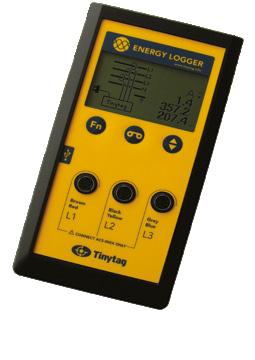
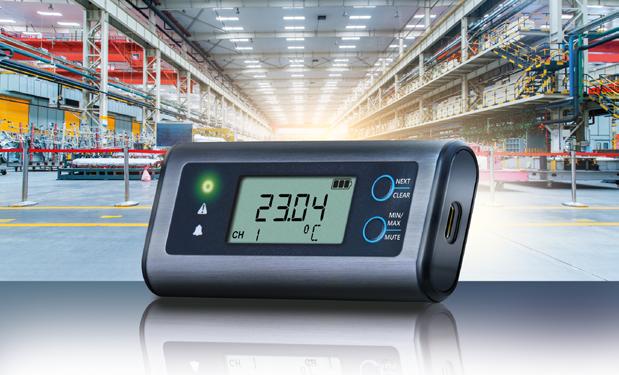
• Rugged and compact
• Easy to use
• Dust, splash or waterproof
• Data downloaded to PC
• Cost-effective
Accompanying probes are available for monitoring extremes of temperature, and for awkward to reach areas such as pipework.
For sites requiring remote data access, Tinytag Radio and LAN loggers gather data automatically for viewing on a PC, across a LAN, or remotely across the inter net.




modes including delayed start at a pre-set time, or a triggered start based on any selected measurement parameter.
In another breakthrough, the EL-SIE is the first USB logger that can be used with the EasyLog Cloud, giving total peace of mind about the security of your data. Once on the Cloud the readings can be accessed from any internet-connected computer or mobile device, and also used with EasyLog’s powerful online graphing, analysis and report generation tools.
The EL-SIE is intelligent and adaptable enough to be perfect for use in a number of markets including facilities and building management, logistics, warehouses and storage, and clean rooms and other pressure sensitive environments.
View the range on our website.
Data logging has evolved.
Lascar Electronics www.lascarelectronics.com
+44 (0)1794 884567 sales@lascar.co.uk
23 Manufacturing & Production Engineering Magazine
temperature » humidity » power usage » co2 » count » voltage » current
Gemini
England Telephone: +44 (0)1243
email: info@tinytag.info www geminidataloggers.com www.tinytag info Manufactured in the UK
application
Data Loggers (UK) Ltd Scientific House, Terminus Road, Chichester, West Sussex, PO19 8UJ,
813000
Solutions Automatic data collection Bundles – 3 loggers/receiver/ software from £1,100 +VAT Radio and LAN Indoor temperature & RH From £80 +VAT Tinytag Ultra 2 Non-invasive single & three phase power monitoring Full kit £995 +VAT Energy Logger
outdoor/industrial temperature/RH logger
£110 +VAT Tinytag Plus 2
Environmental Monitoring
Rugged
From
New MPLAB® SiC Power Simulator Allows Customers to Test Microchip’s SiC Power Solutions in Design Phase
Microchip’s PLECS-based tool quickly evaluates solutions across power-switching topologies before committing design to hardware.
The electrification of everything is driving the growth of SiC semiconductors as large market segments such as E-Mobility, sustainability and industrial turn to SiC power solutions because of its fast-switching capabilities, lower power loss and higher temperature performance. To help power design engineers transition to SiC power solutions with ease, speed and confidence, Microchip Technology has announced its MPLAB® SiC Power Simulator that quickly evaluates Microchip’s SiC power devices and modules across various topologies before committing a design to hardware.
Microchip’s MPLAB SiC Power Simulator is a PLECS-based software environment designed in collaboration with Plexim to provide an online complimentary tool that eliminates the need to purchase a simulation license. The MPLAB SiC Power Simulator accelerates the design process of various SiC-based power topologies. Customers can confidently benchmark and evaluate SiC solutions in the design phase.
The tool can speed up time to market by delivering a comprehensive SiC evaluation that not only provides

valuable benchmarking data but also reduces component selection times. A power electronics designer deciding between a 25 mΩ and 40 mΩ SiC MOSFET for a three-phase active front end converter can get immediate simulation results, such as average power dissipation and peak junction temperature of the devices.
The MPLAB SiC Power Simulator is a critical design tool for OEMs designing power systems for E-Mobility, sustainability and industrial applications that include electric vehicles, on/off-board charging, power supplies and battery storage systems.
Microchip’s SiC portfolio includes industry-leading power module packaging with the lowest parasitic inductance (<2.9 nH), and industryleading 3.3 kV discrete MOSFETs and diodes with the highest current ratings available. The SiC portfolio also includes 700V, 1200V and 1700V die, discretes and modules, as well as AgileSwitch® configurable digital gate drivers.
These SiC devices offer the ruggedness and performance to deliver gate oxide lifetimes that are predicted to be in excess of 100 years and degradation-free body diodes. SiC technology provides higher system efficiency, power density and temperature stability over silicon Insulated-Gate Bipolar Transistors (IGBTs) in high-power applications.
Euroquartz launches new Greenray crystal oscillators with low phase noise and ultralow acceleration sensitivity
Frequency control specialist, Euroquartz has introduced a new range of crystal oscillators (XO) from Greenray Industries Inc. that offer low phase noise and ultra-low acceleration sensitivity. Housed in a compact, rugged 17.3mm x 17.3mm square package weighing less than 3 grams and suitable for hand or reflow soldering, the new RoHS-compliant Y1631 XOs offer sinewave output frequencies between 60 and 130MHz over an operating temperature range from -40 to +85°C. Ultra-low phase noise at 100MHz nominal frequency ranges from -83dBc/Hz at 10Hz offset to -170dBc/Hz at 1MHz offset. Acceleration sensitivity – worst axis tested at 90Hz, 10g – is 2.0ppb/g as standard with low noise 0.5ppb/g and ultra-low noise 0.09ppb/g available to order. Shock screening is per MILSTD-202, Method 213 while random vibration screening is per Method 214. These new oscillators are ideal for use in a wide range of industrial and defence-related applications including telecommunications, mobile radio, mobile instrumentation, airborne and wireless communications and microwave receivers.

Supply voltage requirement is 5V DC ±5% with supply current of 30mA. Additional specifications include frequency stability of ±15ppm from -20 to +70°C and ±20ppm from -40 to +85°C, ageing of ±1ppm in first year and ±3ppm over 10 years at 100MHz nominal frequency.
For more information: www.euroquartz.co.uk
Latest Product Launches 24 Manufacturing & Production Engineering Magazine
Science and Technology
Nuclear Science and Technology
MSc - 1 year full time
time part time Certificate for
MSc - 2 or 3 year part time
MSc - 1 year full time
PG Diploma • PG Certificate
MSc - 2 or 3 year part time (Taught and Distance Learning)

PG Diploma • PG Certificate
Designed to create a generation of
CPD
Short Courses for CPD
generation of nuclear engineers skills to secure a sustainable
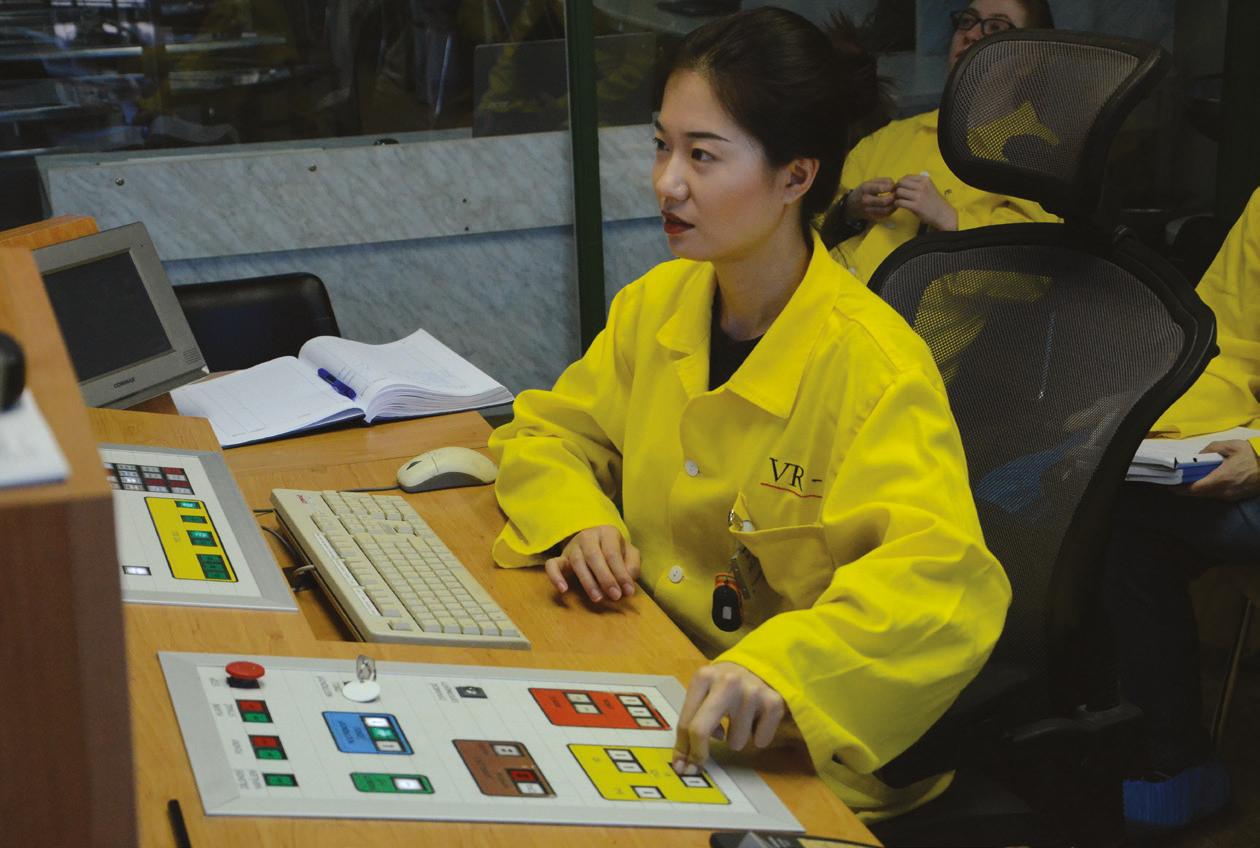


Short Courses for CPD info.ntec@manchester.ac.uk
Designed
Key features:
For more information: email: info.ntec@manchester.ac.uk or visit www.ntec.ac.uk
Demand-driven •Breadth of learning •Delivered by experts •Flexibility
•Short-course format
engineers
nuclear
and scientists with the skills to secure a sustainable and safe future for nuclear energy.
Course delivered by: The University of Birmingham • University of Central Lancashire • The University of Leeds • The University of Liverpool The University of Manchester • The University of Sheffield • The Nuclear Department of the Defence Academy
or visit www.ntec.ac.uk
Demand-driven • Breadth of learning • Delivered by experts • Flexibility • Short-course format
Key features:
nuclear
energy.
Register at: Central Lancashire • The University of Leeds • The University of Liverpool University of Sheffield • The Nuclear Department of the Defence Academy
learning • Delivered by experts • Flexibility • Short-course format
Breadth of
of nuclear engineers and scientists
the
to secure a sustainable and safe
for nuclear energy.
to create a generation
with
skills
future
•
Courses delivered by: University of Birmingham • University of Central Lancashire • University of Leeds • The University of Liverpool • The University of Manchester • The University of Sheffield • The Nuclear Department, Navy Command
info.ntec@manchester.ac.uk
161
4799
For more information: visit www.ntec.ac.uk email:
tel: +44
529
Register at:
Oscar win for Pinocchio puts Made Smarter-backed puppetmaker in global spotlight
Mackinnon & Saunders, based in Altrincham, innovates with 3D printing through North West adoption programme.
The puppet–maker behind the Oscar-winning animation Pinocchio has praised the transformative impact of Made Smarter’s technology adoption programme.

Mackinnon & Saunders, based in Altrincham, collaborated with Hollywood director Guillermo del Toro to manufacture the miniature stars of the hit Netflix stop-motion animation. Pinocchio is the first puppet that has been made using 3D printed stainless steel.

The innovation was made possible through the Made Smarter North West adoption programme, a governmentfunded initiative to help SME manufacturers digitalise, decarbonise
and drive growth through new technologies and skills.
Funding support and impartial expert advice enabled Mackinnon & Saunders to test and trial brand new 3D techniques with Laser Prototype Europe (LPE), a rapid prototyping service bureau based in Belfast.
Pinocchio followed up its incredible clutch of awards, including a BAFTA and Golden Globe, with the Oscar for ‘best animated feature’.
Founded by puppeteers Peter Saunders and Ian Mackinnon 30 years ago, Mackinnon & Saunders have brought to life some of children’s most beloved TV characters including Bob the Builder, Postman Pat and the new Clangers. The company has built a global reputation through collaboration with Hollywood directors Tim Burton on Mars Attacks!, Frankenweenie and Corpse Bride; and Wes Anderson on Fantastic Mr. Fox.
The team of sculptors, costume makers, metal workers and painters have found success blending traditional skills with new technology and processes.
The success of Pinnochio has cemented Mackinnon & Saunders’ position at the top of their game.But for Peter, none of it would have been possible without programmes like Made Smarter.
Enter the LEEA Awards 2023 to celebrate your excellence
The LEEA Awards 2023 will be bestowed during the prestigious Awards Dinner, which will be held at the Rum Warehouse in Liverpool on the evening of 21st November 2023. It’s time to make your award entry now at awards.leeaint.com.
The fifth annual LEEA Awards plays a vital role in promoting the gold standard offered by members of the Lifting Equipment Engineers Association (LEEA). The finalists and award winners will be recognised by fellow members and customers as among the best companies in the industry.

By entering the awards you will raise your profile as a successful business or operator and a leader
in your award category, while also rewarding your teams and celebrating your achievements. Successful entrants will receive valuable editorial coverage in The Lifting Engineer publication, both in print and online, and gain endorsement from an independent panel of industry experts.
Making applications for the LEEA Awards 2023 could not be easier and entries can be made in multiple categories if wished. There is advice and guidance on how to open an account and start making nominations on the registration page at awards.leeaint.com. The portal enables applicants to track their entries and to save the entry to add to and submit later. The nomination portal
Launched in the North West in 2019 to help businesses digitalise, decarbonise and drive growth, Made Smarter has supported more than 2,500 businesses offering fully funded support including expert, impartial technology advice, digital road-mapping workshops to help manufacturers take their first steps to transform their business, and skills development.
Made Smarter has also helped 250 manufacturers invest £18M in technologies which enable them to integrate systems, capture and analyse data, and even create simulations of their plants and processes, others are now using 3D-printing, automation, and robotics to solve business challenges and meet increased demand.
By adopting cutting-edge technologies, these businesses are benefiting from improved productivity and revenue, increased exports and job creation, an upskilled workforce, lower energy bills, and a reduced carbon footprint. Almost 1,300 new jobs are forecast to be created, 2,400 existing roles upskilled, and an additional £209M in GVA for the North West economy over the next three years.
For more information, visit www.madesmarter.uk
will close for award entries on Monday 21st August 2023.
Don’t hesitate in making your entry to ensure your nomination has a chance of winning a prestigious LEEA Award.
The Awards Dinner at the Rum Warehouse will be the industry’s party of the year and a showcase social networking event. To sponsor an award category, book a table of 10 guests, or to buy individual tickets, please contact Leah Phelps on +44 20 3488 2865 or at enquiries@L2Events.com
26 Manufacturing & Production Engineering Magazine
Events & Awards News
Events & Awards News
Reshoring, innovation, and investment in people help Brandauer claim two CBM Awards

One of the West Midlands’ best kept manufacturing secrets has capped a record-breaking year by securing two major industrial awards.
Brandauer, which produces millions of high tolerance metal pressings/stampings every week for customers in 10 sectors and across 26 different countries, was named the Confederation of British Metalforming’s Company of the Year in front of 200 people at Birmingham’s Grand Hotel.
Judges praised the Birminghambased company for its resilience and ability to bounce back from the pandemic, developing a unique lamination process for electrification and increasing its tooling business from £500,000 to £2m per year.
This has seen it take turnover past £9m for the first time in its 161-year history, including new orders for a
Slovenian automotive supplier of HVAC systems, a new $3m supercar and reconnaissance drones.
Working in partnership with InComm Training, the firm has also launched the UK’s first £1m Precision Tooling Academy to help develop the next generation of toolmakers.
In addition to company of the year, Brandauer’s Toolroom Lead Ollie Eskriett beat off the challenge of three other finalists to win the CBM’s best apprentice.

Ollie Eskriett’s success underlies how far the 23-year-old engineer has come and the role he played in launching a quick clip modular tooling concept, one of the first projects in the country to win funding from Innovate UK’s Covid-19 BusinessLed-Innovation in Response to Global Disruption Fund.
The company invested £75,000 to develop a quick changeover capability
to a progression tool, giving it the option to manufacture the clips – used in medical face masks all over the world - in multiple profiles, widths, thicknesses and lengths.
This move has secured over £500,000 of reshoring business from Asia over the next five years and extends the company’s production capacity to 140 million nose clips per year.
For further information, please visit www.brandauer.co.uk


27 Manufacturing & Production Engineering Magazine
Application - Aircraft Screwdriver Fastener Torque Control
Interface Force was recently approached by an Aircraft manufacturer who wanted to ensure the correct torque and clamping force were being applied to fasteners during assembly.
The Customer’s Challenge
An aeroplane manufacturer needs a solution where they can control the torque when fastening screws on their aeroplane models. They do not want to create any damage to materials or apply too much torque when plane components are being fastened together.
Interface’s Solution
Interface’s Model T15 Hex Drive Rotary Torque Transducer can be attached to the fastening workbench, measuring and recording torque, rotational speed and angle of the screwdriver. The LWCF Clamping Force Load Cell is installed, measuring the forces applied on the screw being fastened.


Interface’s Model T15 Hex Drive Rotary Torque Transducer can be attached to the fastening workbench, measuring and recording torque, rotational speed and angle of the screwdriver.
Results are sent to the SI-USB4 4-channel USB Interface Module, which is connected to the customer’s PC or laptop where data is logged, graphed and displayed.
The Results
The aeroplane manufacturer was able to calibrate their screwdriver by measuring its torque, rotational speed, and angle when attaching components to their aeroplane. They were also able to measure the forces being applied to the screw, to ensure it was not applying too much torque to the components.
Items Used to Complete the Test
• T15 Hex Drive Rotary Torque Transducer
• LWCF Clamping Force Load Cell

• SI-USB4 4-channel USB Interface Module
• Customer PC or Laptop
How It Works
1. The T15 Hex Drive Rotary Torque Transducer is attached to the screwdriver fastening bench.
2. The LWCF Clamping Force Load Cell is placed beneath the bolt head.
3. The T15 Hex Drive Rotary Torque Transducer measures the screwdriver’s torque, rotational speed and angle, for the customer to determine the right amount of torque needed to be applied to the screw to prevent any damage to the materials being fastened together.
4. The LWCF Clamping Force Load Cell measures the forces applied to the screw, so the customer can determine the maximum torque it can take.
5. The measurements and results are sent to the SI-USB4 4-Channel USB Interface Module, where the customer can record the results when connected to their PC or laptop.
For more information about the force and torque sensors mentioned in this application note or how Interface Force Measurements could help with your force, torque or pressure measurement challenges please email us at info@interface.uk.com or visit our website www.interfaceforce.co.uk
28 Manufacturing & Production Engineering Magazine
Measurement, Sensors & Monitoring
Scientific Instruments: Changing the World of Research
By Phil Simmonds, Chief Executive Officer of EC Electronics.

We are living through an age of technological revolution, where science and innovation come together to achieve life-changing breakthroughs that are helping us to understand the past, improve the present and shape the future.
Scientific instruments are at the heart of these developments, allowing researchers to gain new insights and unlock more secrets from the world around us. And as the capabilities of the internet of things (IoT) and other advanced technologies expand and integrate with industrial equipment, laboratories and other research hubs are becoming more connected than ever before.
These instruments and devices already come in all shapes and sizes — from a simple thermometer to the Large Hadron Collider — and it looks like instrumentmakers are only just getting started. By harnessing modern technology, equipment developers can enhance and extend instrumental functions far beyond what we had previously imagined to revolutionise research and accelerate scientific outcomes.
Creating the laboratories of the future
The technology that goes into scientific instrumentation is becoming increasingly refined, with the miniaturisation of electrical components giving way to new technologies, such as lab-on-a-chip (LOC).
A LOC device integrates several laboratory functions, such as chemical synthesis and DNA analysis, in a tiny chip. The emergence of this technology
has had many benefits for research and development (R&D) centres, including reducing sample sizes to create less waste and enable shorter analysis times.
This technological innovation is made possible by the IoT, which gives scientists access to unprecedented volumes of data. IoT sensors facilitate enhanced connectivity between equipment and laboratory information management systems (LIMS), supporting advanced data collection, software analysis and predictive maintenance to improve efficiency in industrial and scientific settings.
Automating these processes can also reduce the risk of human error and allow researchers to spend more time on collaboration and idea development. As much as 70% of lab workers’ time can be wasted on repetitive administrative tasks, data management and preparation work, so mechanising these functions can lead to a significant productivity boost.
Additionally, modern connective technologies allow scientists to access equipment remotely, which has several benefits for the research community. From promoting resource sharing between labs to allowing researchers to conduct their work on the move, the rise of the virtual laboratory could lead to several breakthroughs.
The possible applications for nextgeneration scientific instruments in the R&D sector are driving significant growth in this market, which is expected to expand at a compound annual growth rate (CAGR) of 3.9% from 2022 to 2029

This multi-billion-dollar industry presents several attractive opportunities for product developers. However, it is vital that scientific and industrial instrumentation equipment manufacturers do not compromise quality in favour of affordability in the race to the production finish line…
Manufacturing electronics for scientific instruments
Advanced scientific instrumentation can give researchers a competitive edge, with rapid data collection and analysis
speeding up processes to achieve faster, more accurate results.
However, designing these devices involves increasingly complex technical and logistical considerations.
As labs embrace the latest scientific instruments to attain new capabilities, customers see quality assurance as a defining factor — especially as they place more functions in the hands of autonomous devices. So, every equipment component must meet stringent regulatory standards at every stage of the development cycle.
Implementing the latest technologies requires constant troubleshooting and monitoring, meaning every system must generate reliable data and facilitate flawless connectivity. In scientific environments, intrinsic safety and accuracy are imperative, so product developers must guarantee accuracy to prevent faults and downtime from tarnishing results or disrupting progress.
Electronics provide the backbone of the modern tools and equipment found in research centres and laboratories worldwide. So, it is crucial to find an electronics manufacturing services (EMS) provider with an established track record of developing high-quality products for scientific environments.
Measurement, Sensors & Monitoring
Automation UK set to be the largest annual event in the UK showcasing leading automation and robotics suppliers

Automation UK, the new exhibition highlighting the importance of robotics and systems integration to the future growth of the UK economy, is poised to be a sell-out event as the countdown to the show enters its final weeks. Taking place at the Coventry Building Society Arena, between 20th-21st June 2023, the unique event highlights the latest products, developments and solutions in robotics and automation, with solutions on display for visitors to improve efficiency and productivity in their operation.
Owned and organised in conjunction with BARA (British Automation & Robot Association), the event is designed to promote the use of, and assist in the development of, industrial robots and automation in British industry. Being owned by the industry, for the benefit of the industry, means there are many BARA members exhibiting – each showcasing their latest products and services, with experts on hand to offer advice and support.
Big names exhibiting include ABB, CKF, FANUC, Festo, KUKA Robotics, Mills CNC, Piab, Pilz Automation, RM Group, Schubert and Yaskawa. Joining them will be nearly 40 other companies all active in the sector and looking to raise their profiles and generate new business.
Oliver Selby, Head of Sales, FANUC UK said: “The FANUC UK team is delighted to be a founding exhibitor at Automation UK. As evidenced by the increase in enquiries we are receiving, there is a real need for a dedicated automation and robotics show such as this. We’ve been a longstanding member of BARA and are proud to support them in helping to raise the profile of automation among UK manufacturers, showcasing the wideranging benefits it can deliver.”
Co-located with Automation UK is the UKIVA’s (UK Industrial Vision Association), Machine Vision Conference (MVC), a well-established and successful machine vision confex event. This means visitors to Automation UK will also be able to cross-over and see the latest developments in industrial vision and imaging systems.
Recognising the vast potential of automation and robotics to British industry, BARA’s aim in establishing Automation UK is to shine a spotlight on the disruptive technologies and to highlight their true value to the wider economy. Automation UK also promises to be the largest annual gathering of industry experts under one roof in the UK.
The event has been specially designed for businesses operating in the automation and robotics markets. Showcasing the latest products and services, the show will feature live demonstrations of the latest machines. Visitors attending the event will be able to see live working demonstrations of the latest automation and robotics technology, helping them make informed investment decisions on their next machine.
Visitor registration for this free-toattend event is now open, and the strong numbers suggest it is proving an attractive prospect for the industry. Attendees will have the opportunity to meet new suppliers, learn about new technology and new techniques as well as explore how this rapidly developing sector can help improve their business efficiency, productivity and accuracy.
Face to face meetings will allow visitors to clearly convey the complexities and challenges they face in their own operation. With multiple suppliers, technicians, experts, advisory bodies and advocates all under one roof, a day spent at Automation UK, finding out more about these exciting, transformative technologies, will save a visitor hours of internet trawling and weeks of arranging meetings.
A vibrant seminar programme, located in the arena’s exhibition hall and led by BARA, will deliver a range of informative,
content-led topics around the opportunities of automating equipment, processes and systems as well as the benefits this highly repeatable and reliable process can bring to a visitors business.
Mark Stepney, Managing Director of Schubert UK and a PPMA board member, said: “Automation UK and MVC will be the largest annual event in the UK to showcase leading robotic and vision suppliers. Its legitimacy is underlined by the backing of two leading industry associations – BARA and UKIVA – and will be an event not to be missed.
“Aside from being able to view live demonstrations of the latest machines, talk to exhibitors face-to-face and gain the latest market intelligence from industry experts, we have a very competitive offer for exhibitors and one we believe they will find very attractive, not least because the show is open to all suppliers and prospective purchasers.”
Both the BARA and UKIVA are members of the PPMA (Processing and Packaging Machinery Association) group of trade associations. The PPMA is the UK trade association for suppliers of processing and packaging machinery to both the domestic and overseas markets. With more than 550 member companies, the association’s principal objective is to help members sell more products and services through the PPMA Group’s various exhibitions, publications and training.
For more information on visiting Automation UK and how to register, visit www.automation-uk.co.uk
30 Manufacturing & Production Engineering Magazine
Show Preview
Face to face meetings will allow visitors to clearly convey the complexities and challenges they face in their own operation.



NEW EXHIBITION Free Entry Bringing industrial automation and robotics to life Visit Automation UK – See live demonstrations of the latest automation and robotics technology. automationukshow automationUK_23 automation UK automationukshow Co-located with Register for your FREE visitor pass today, visit automation-uk.co.uk
Seeley International announces senior sales appointment for UK and Ireland
Seeley International has announced the appointment of Mr. Fabio Marioni as the new Sales Manager for United Kingdom and Ireland, in an important move to expand business in these two key countries.
Mr. Marioni will implement crucial aspects of the company’s growth strategy, including coordinating contractors’ network and promoting Seeley International’s premium quality evaporative cooling technologies.

Mr. Marioni comes to Seeley International with significant experience working in the HVAC industry, such as Epta Refrigeration, Galileo TP and Ziehl-Abegg.
In welcoming the appointment, General Manager Sales EMENA, Mr. Sam Peli, said the addition of Mr. Marioni to the team would drive sales growth and reinforce Seeley International reputation as an industry leader.
“Seeley International’s success is achieved through a combination of attracting and retaining only the very best people, and an unwavering commitment to developing innovative
and high-quality products,” Mr. Peli said.
“As part of the role, Fabio will promote award-winning climate control solutions developed by Seeley International, as they will help the environment and achieve serious savings for users, because they cost less to run than other products on the market.”
“I am proud to be part of this marketleading & award-winning company. Seeley International offers an impeccable reputation for innovation, quality, reliability and safety, and I look forward to working with customers to showcase the unrivalled technology and energy efficiency benefits offered by Seeley International’s products.” Mr. Marioni said. “I am ready to play a role in taking the business to the next level in the UK and Ireland.”
Why choose evaporative cooling for your industry?
Evaporative cooling is fast becoming the preferred option when cooling industrial and commercial spaces. Only using water and electricity to run, this solution is extremely costeffective. Air conditioning is not such a
viable option, because in warehouses and industrial plants the capital and running costs would be extremely prohibitive: for this reason, facilities managers are choosing evaporative cooling, which can cool at a fraction of the cost of refrigerated systems.
Easy to install and maintain, these coolers bring 100% fresh air from outside (they don’t recirculate indoor air). They are therefore perfect to enhance Indoor Air Quality (IAQ) and improve ventilation, positively impacting on workforce wellbeing and productivity. Illnesses such as heat stroke, asthma and other diseases connected to high temperatures are reduced.
Traditional air conditioning systems normally use chemical refrigerants to cool the air, whereas evaporative cooling only needs water and little electricity to run. Thus, every time a customer chooses to install evaporative coolers over a refrigerated system, the benefits for the environment are significant.
For more information: www.seeleyinternational.com
32 Manufacturing & Production Engineering Magazine
Company News
Seeley International’s success is achieved through a combination of attracting and retaining only the very best people, and an unwavering commitment to developing innovative and high-quality products.
- Mr. Sam Peli
ACORN® Secure Super Precision Bearing Partnership
ACORN is excited to share the news that it has been appointed as SKF’s Super Precision Bearing Partner - the world’s first and only of its kind. This partnership is an important milestone for ACORN and will enable the company to offer its clients the highestquality precision bearings available in the market with same-day despatch on hundreds of stocked items.
SKF Super Precision Bearings are renowned for their exceptional performance, high-speed capabilities, and system rigidity, making them the ideal solution for any high-speed industry. By partnering with SKF, ACORN can now offer a superior range of stock levels, including single, universally faced bearings that can be easily combined to meet any specific requirements.
Sustainability is a key driver for Allpack’s Packaging Solutions
Since 1994 Allpack has been providing sustainable packaging supplies and solutions to a wide range of customers, who know they are using industryrecognised products, designed specifically for their intended sector and application.

Sustainability is a key mission for Allpack, as we are proud to be a Forest Stewardship Council® (FSC) certified business, ensuring we source, supply and deliver sustainable solutions, to our business partners and clients. We work hard to select and maintain supplier’s products that are manufactured from at least 30% recycled content and are 100% recyclable making them Plastic Tax Compliant, which is better for you, your customers, and the environment.
Contact Allpack today at 01543 396 888, or email sales@allpack.uk.com to discuss your packaging enquiries and see how we can assist you in selecting sustainable and greener packaging products, or visit www.allpack.uk.com to view our range of marketleading sustainable packaging products and brands.
Bearing Product Manager, Andy Fletcher commented:
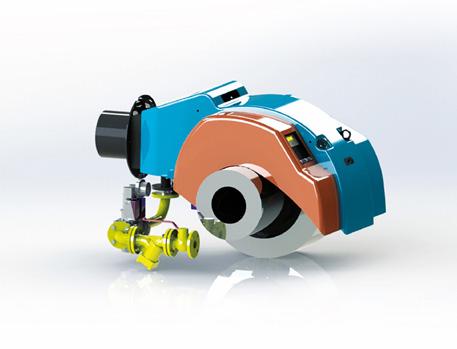
“ACORN has placed a significant investment in stock to supply SKF Super Precision Bearings off the shelf meaning that clients are no longer constrained by long lead times. The increased flexibility in the supply chain enables businesses to be up and running faster, ultimately leading to increased profitability. The partnership with SKF cements ACORN’s position as a leading supplier of precision bearings and machine-building components.”

Being appointed as SKF’s firstever Super Precision Bearing Partner offers customers the assurance that they can get the parts they need, when they need them, allowing businesses to achieve optimal performance with the highest quality products, delivered quickly and efficiently.
Website: www.acorn-ind.co.uk
Babcock Wanson Extends Modulo+ High Performance Gas Burner Range
Industrial process heating specialist Babcock Wanson has extended its Modulo+ gas burners to encompass smaller boilers ranging from 2.5 to 3.5 t/h of steam output. Modulo+ burners are now available from 1,700kW to 22MW output, operating on natural and liquefied gas.
Modulo+ gas burners are designed with digital micromodulation control and specially developed combustion head for high turndown and very low NOx emissions, down to 60mg/Nm³ at 3% O2. The 12:1 turndown ratio means improved efficiency and lower overall losses due to a reduction in the number of purge cycles. The design of the burners provides very accurate control of excess air over the entire operating range, resulting in an excellent combustion efficiency no matter what the process load, and the lowest practicable operating costs.
For more information, please contact Babcock Wanson on 020 8953 7111 or info@babcock-wanson.co.uk or go to www.babcock-wanson.com/products/industrialburners/modulo/
33 Manufacturing & Production Engineering Magazine Company News
Ewellix launches the e-MOVEKIT to reduce design and validation time for mobile machinery
Ewellix, the leading global innovator and manufacturer of advanced linear motion technologies, has introduced a new e-MOVEKIT to help designers and manufacturers of mobile machinery simplify the specification, assembly, and testing of electric linear actuation systems.
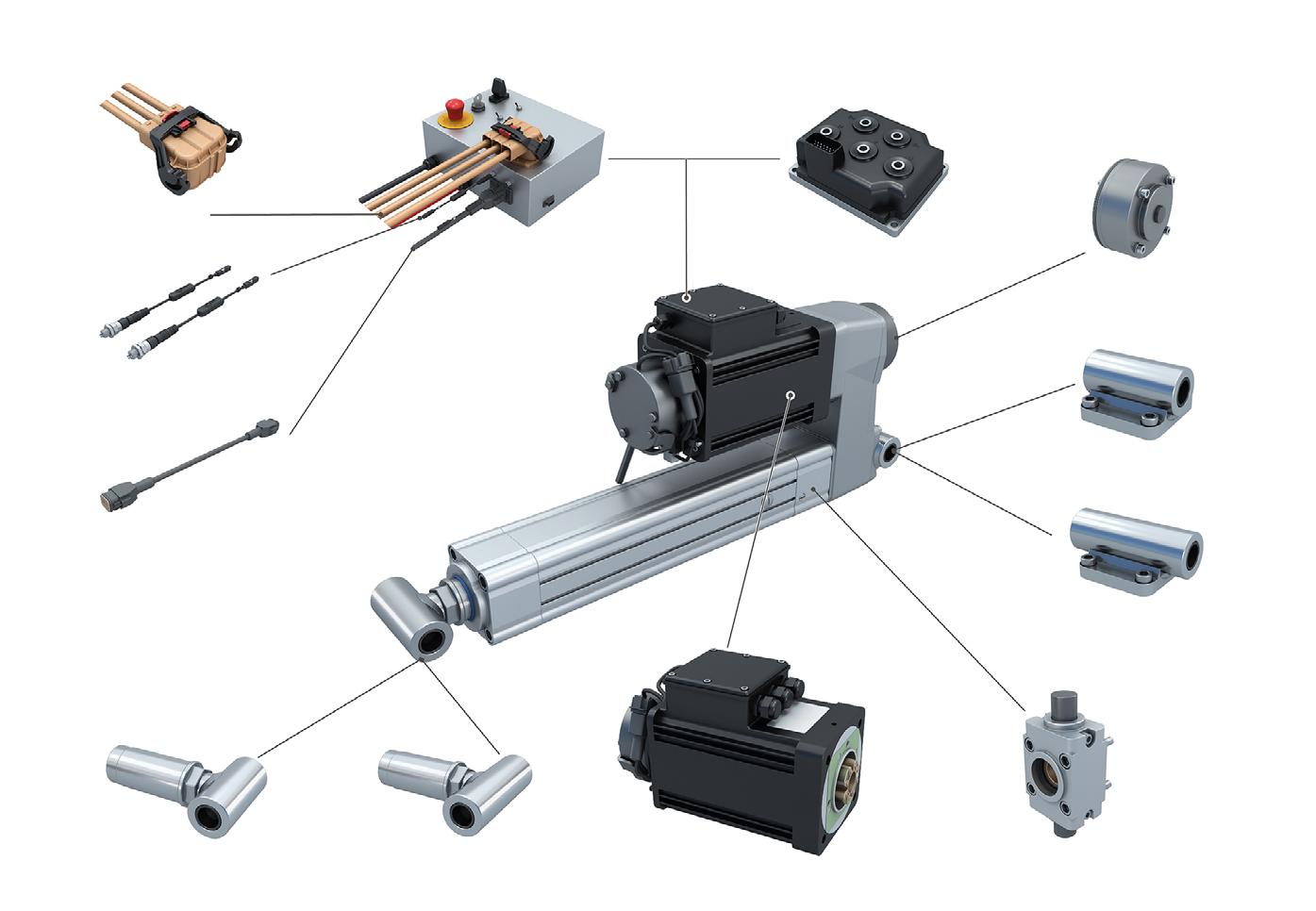
The e-MOVEKIT has been developed in response to the growing trend towards electrification of motion systems in mobile and off-highway equipment. In particular, the demand to replace
traditional hydraulic devices with a new generation of electric actuators that offer high levels of power-density, far greater max. force capacity, energy efficiency, safety, and reliability.
In essence, the new e-MOVEKIT is a complete system with all the components that are needed to drive and control linear motion in mobile machinery fitted with a 24V power source, with either analogue or CAN-bus standard controls.
At the heart of each e-MOVEKIT is one of Ewellix’s advanced modular
electric actuators. These are designed to be used with a wide range of highperformance motors, gearboxes and end attachments, all of which are supplied as part of each kit. Each kit will include all the connectors, cables and mounting attachments needed for simplicity of installation.
The concept behind the e-MOVEKIT is to make it easy for engineers who are already experienced in linear motion, as well as those who may not have previously worked with electric actuators, to be able to quickly and easily specify, customise and configure effective solutions for mobile equipment. The simplicity and speed of specification makes the new e-MOVEKIT ideal for both prototype development projects as well as full-scale equipment build.
One of the many advantages of the new e-MOVEKIT is that Ewellix electric actuators offer a range of benefits to be easily built into each machine. For example, regenerative braking can be initiated when each actuator is being driven under load, while safety features such as a descent speed limiter, back-up nut and electromechanical motor braking can easily be incorporated.
The e-MOVEKIT looks set to transform the way in which electric linear actuators are specified and used by OEMs, providing a plug and play option for the replacement of traditional hydraulic cylinders, while helping to reduce design and commissioning times.
New LEM current sensor delivers best-in-class charge measurement accuracy for Li-ion EV batteries
To enable designers of Lithiumion battery management systems (BMSs) in the automotive sector to maximise the autonomy range of electric vehicles (EVs), electrical measurement technology specialist LEM has launched its new CAB 1500 current sensor which offers best-in-class performance for accurate battery charge level measurement.
One of the biggest issues in the EV sector is the need to develop vehicles that can travel the furthest possible distances between charges and so design engineers are continually searching for sensors that can offer the superior levels of efficiency and accuracy they require.
The CAB 1500 is the latest member of LEM’s CAB series of automotive grade design sensors that use the properties of fluxgate transducer technology to deliver the high accuracy and low offset required for reliable coulomb counting –measuring the discharging current of Li-ion batteries to estimate their state of charge (SoC). The CAB series is renowned for compliance with the ISO 26262 functional safety standard (to automotive safety integrity level C) as well as easy application through a controller area network (CAN) interface offering 500 kbps.
Backed by LEM’s 50 years’ experience in developing electrical measurement solutions, the CAB 1500
open loop fluxgate sensor – equipped with electronic mechanisms and software that guarantee the levels of reliability required by BMSs – can be busbar or panel mounted and combines best-in-class resolution up to 0.1% with the lowest offset and highest accuracy.
As well as offering an extended current range up to ±1500A and compatibility with 800V applications to the IEC 60664-1 standard, the new sensor boasts non-intrusive measurement for full galvanic isolation up to 2.5kV.
Other features include low power consumption VS shunt technology and 0.5% total error over temperatures from -40°C to +85°C.
Latest Product Launches 34 Manufacturing & Production Engineering Magazine


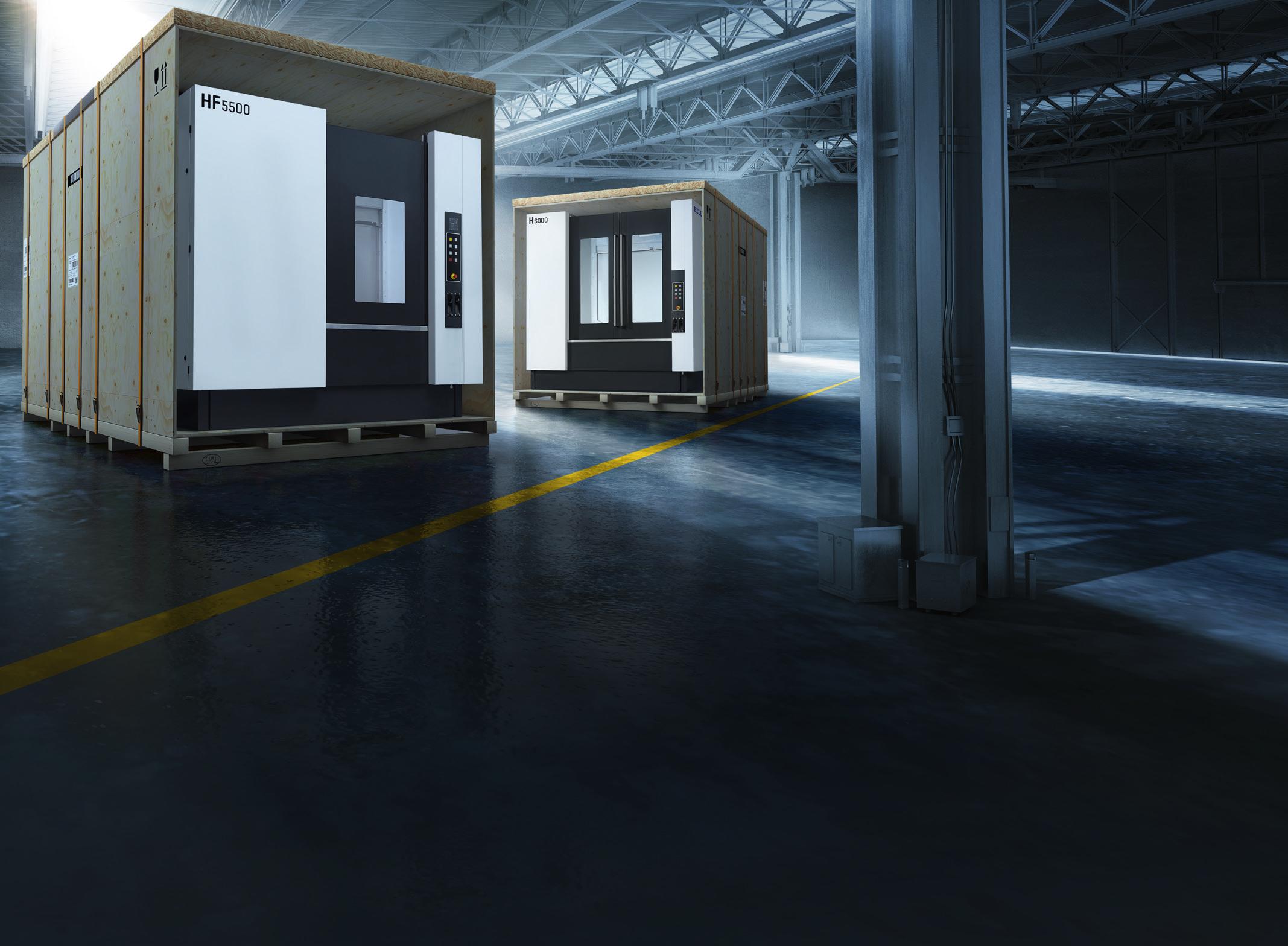
35 Manufacturing & Production Engineering Magazine GET A QUOTE: T:0121 585 2724 / WWW.TOTALKARE.CO.UK Totalkare’s ergonomic positioners are single or double column devices that enable the lifting and rotation of a product during welding and assembly operations. With overall capacity from 2,000 - 90,000kg to suit, they are both compact and flexible. Ready4Ready2deliver productivity Find the right machine now: www.heller.biz/en/ ready4productivity The quick way to boost your productivity Discover the 4-axis and 5-axis machining centres from our H and HF series available at short notice: pre-configured and available in a range of specifications to meet your specific production requirements! HEL-DE-J-23683_Ready_UK_180x132.indd 1 20.04.23 10:28
Registration opens for the 46th annual edition of Subcon: the
UK’s largest subcontract manufacturing supply chain
show
• Registration is free
• Less than 25% stand space remaining
• Sponsors: OMNIDEX, Turkish Machinery
• Machinery magazine joins The Engineer and Manufacturing Management to deliver a practical twoday conference
Subcon 2023 registration now open! The event will be held 7-8 June, at the NEC, Birmingham and will deliver hundreds of UK and international suppliers, thousands of the latest products, and topical content on the challenges, pain-points and opportunities for the manufacturing industry.

Over 200 exhibitors will be displaying their products and latest innovations. 75 per cent of stand space has been sold, with Dawson Precision Components, European Springs & Pressings, Keyence UK Ltd, Plastic Coatings Ltd, Truturn Precision Engineering Ltd, WLR Prototype Engineering Ltd and many more, already confirmed to exhibit.

In addition to the exhibition, the leading industry journals, The Engineer,
Manufacturing Management, and new for 2023, Machinery magazine, have curated an informative agenda across two conference theatres. Visitors can take-away practical skills and learnings from case-study led presentations and panel discussions covering topics including AI and automation, agility and resilience, additive manufacturing, cybersecurity, sustainability, digitalisation and much more.

There will also be plenty of dedicated networking areas at the show including a VIP zone. Over 20% of visitors to Subcon are VIP attendees and have a buying power of 500k a year.
Event director, Jason Dante commented “Subcon opens its doors to the full manufacturing ecosystem.
“With the industry facing a multitude of challenges from soaring costs to supply chain shortages, there’s never been a more critical time for suppliers and visitors to meet. With nearly half a century’s experience Subcon provides the perfect platform to facilitate this.”
36 Manufacturing & Production Engineering Magazine
Click here to register for free Show Preview
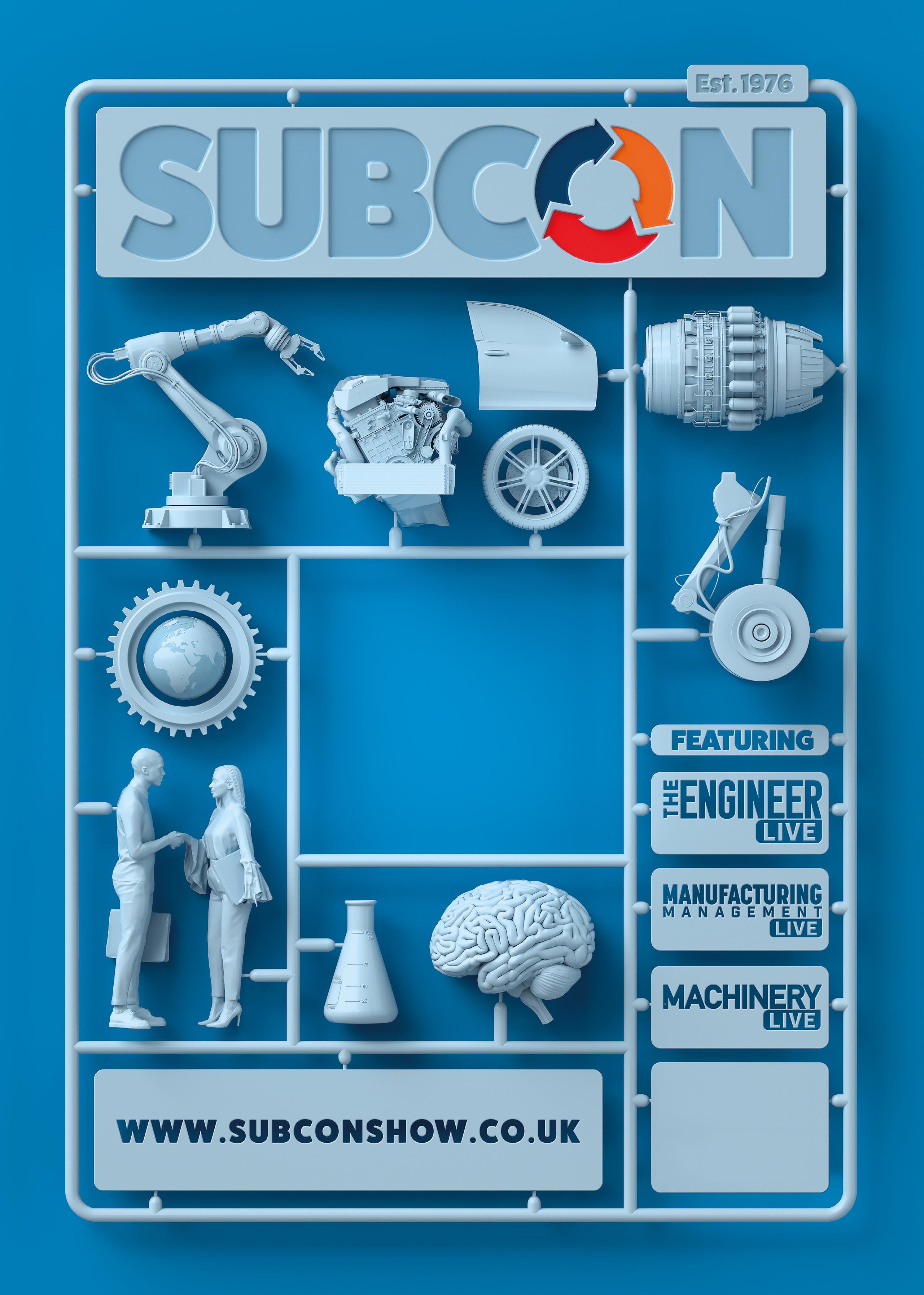
7-8 JUNE 2023 • THE NEC BIRMINGHAM JOIN THE CONVERSATION @SubconShow #SubconShow THE UK'S LARGEST SUBCONTRACT MANUFACTURING SUPPLY CHAIN SHOW JOIN US IN JUNE AT Register your interest today! Scan the QR Code to register your interest
High brightness TFT LCD display easily fits in
Relec Electronics offers a high quality, 21.5” HDMI TFT LCD display. The HA-215HVEEUAB0-AA is designed for easy integration into any equipment where a high quality, large display screen is required for indoor use.
The HA-215HVEEUAB0-AA is a simple way to incorporate a large display into equipment. It has a screen size of 21.5″, and provides a large active area of
476.06mm (wide) x 267.79mm (height) with an aspect ratio of 16:9. Resolution is 1920 x 1080.
The versatile TFT LCD display is equipped with an HDMI interface, LED backlight driver and pre-installed EDID (extended display identification) which identifies the video source and the display hardware so that the video resolution is appropriate and optimised for the hardware.
Compact, dual channel units for cost-effective monitoring
Monitoring the dynamic behaviour of smaller rotating machinery such as gas turbines, pumps, motors, fans and centrifuges has become increasingly important in today’s highly competitive, costconscious environment. Having access to devices which provide cost-effective yet sophisticated monitoring for this type of plant and machinery is why condition monitoring specialists developed their DN26 G3 machine protection system.

The DN26 G3 dual channel protection system has been well established in the market for many years and Sensonics have supplied 1,000’s of these compact, din rail mountable units for a wide range of small to medium machinery monitoring applications. Demand continues to grow as illustrated by a recent delivery of 25 x DN26 G3 dual channel vibration monitors to a Middle East based Gas Transmission company underlining the successful application of these innovative and
cost-effective monitoring systems across a broad range of installations.

At this site these panel mounted monitors are being used on existing Dresser-Rand turbine compressors in a gas pressure booster station. They will be monitoring radial shaft vibration and axial shaft position (eddy current proximity probes) on the compressor and for the turbine will be monitoring absolute casing vibration (high temperature accelerometers) at both the gas generator and power turbine locations.
The dual channel din rail mountable DN26G3 unit provides monitoring of bearing vibration, shaft vibration, or shaft position with fully programmable signal conditioning and includes a range of measurement algorithms and sensor options. The unit is designed for optimum flexibility; as a universal module (single hardware platform) and is field upgradable and fully programmable.
Special protection options include slow rotation vibration monitoring down to 0.2Hz and narrow band filter
The high brightness level of 500cd/ m2 ensures reliable performance in a wide variety of indoor applications and environments, from medical and industrial use to marine and defence applications.
The operating temperature range is -10°C to +60°C and storage temperature range is -20°C to +70°C. Supply voltage is 12 Vdc.
Versatility is further enhanced with Relec’s range of touch panel options: PCAP and resistive.
Other modifications available are optical bonding, screen enhancements and enhancement films, mounting frames, custom cables and adaptor boards.
There is also a custom cover lens design which offers a variety of options, including custom size, shape and design, apertures for other connections, thick and strengthened glass and custom printing.
Other key features of the HA215HVEEUAB0-AA 21.5” display include the use of IPS (in-plane switching) for wide viewing angles, 16.7m colours, an LED lifetime of 50,000 hours and low power consumption.
measurements for specific vibration signatures. In addition the unit offers a dedicated speed monitor channel which can also be utilised as a phase reference for further harmonic analysis of the vibration signals.
The sensor interface is programmable to accept IEPE type accelerometers / velometers, proximity probes (API 670 standard), and active / passive speed probes.
The unit is designed for optimum flexibility; as a universal module (single hardware platform) and is field upgradable and fully programmable.
Product News 38 Manufacturing & Production Engineering Magazine

Manufacturing Managers are Struggling with an Increased Workload
Almost half of managers within the manufacturing industry (47 per cent) report that their responsibilities have increased since COVID, with over a fifth (21 per cent) finding it more difficult to stay positive at work. These are the findings from O.C. Tanner’s 2023 Global Culture Report which collected and analysed the perspectives of over 36,000 employees, leaders, HR practitioners, and business executives from 20 countries around the world, including 2,792 from the manufacturing industry.
The report reveals that the new responsibilities and expectations placed on managers over the past few years have resulted in many succumbing to stress and burnout. In fact, almost a third of manufacturing workers (31 per cent) report that their direct managers seem stressed.

“This increase in workload for managers is negatively impacting their wellbeing and engagement, as well as overall company culture” says Robert Ordever, European MD of O.C. Tanner. “They are expected to do far more but with the same if not fewer resources, and eventually something has to give and it’s all too often their mental health.”
The report highlights that the main managerial tasks taking up more time since COVID are project/team meetings (41 per cent of manufacturing managers report an increase). This is followed by management meetings (39 per cent) and training and mentoring (37 per cent). Despite these additional tasks, 19 per cent of manufacturing managers admit that they are finding it more difficult to receive support from senior leaders.
Ordever says, “Managers are stretched far too thinly these days, with meetings and mentoring occupying more time than ever before. Leaders must recognise this and find ways to ease their burden.”
The Culture Report recognises that while it may not be possible for an organisation to ease every managers’ workload, managers can be provided with a robust support network where they
Europe’s biggest robotic parcel sorting system goes live in Turkey
Europe’s largest automated robotic parcel sorting system has been installed in Turkey by the leading Turkish-owned parcel distribution and postal services company, Kuryenet.
The system was designed and fitted by LiBiao Robotics in conjunction with its Turkish distribution and after sales support partner, Lodamaster, at the Kuryenet facility in Tuzla, a small town on the outskirts of Istanbul.
As well as being the biggest robotbased sortation system in Europe, the Kuryenet installation is the first of its kind to be deployed in Turkey.
The sortation system – which uses 120 LiBiao ‘Mini Yellow’ autonomous mobile robots (AMRs) to connect over 700 destination chutes with 5 parcel induction points - has the capacity to

Latest News 40 Manufacturing & Production Engineering Magazine
can seek advice, ask for help and share best practice. They can also be made to feel valued and appreciated. In fact, 76 per cent of manufacturing managers agree that receiving more recognition for their work would improve their employee experience, with leaders and managers who work in organisations with a culture of recognition, having a 38 per cent reduced chance of developing anxiety. Ordever adds, “Managers need support and recognition just as much as any employee. This must be given regularly and authentically, with appreciation integrated into everyday culture so that it flows in all directions. Managers will then feel part of a caring workplace community in which their contributions are continually seen and valued.”
process some 45,000 items per hour.
Each of the fast-moving sorting robots has a load capacity of up to 10kg and uses collision avoidance technologies to perform their routebased sorting tasks safely.
At each induction station a worker places a parcel onto a waiting robot at which point the package’s shipping label is automatically scanned and a destination chute is assigned based on the town or city to which the parcel is bound.
The LiBiao ‘Mini Yellow’ robot’s navigation system directs each robot and its load to the assigned chute and, on arrival, the parcel is tipped into a waiting mail sack.
The control system indicates when a sack is full and detailed delivery information is printed and attached to the mailbag before it is transferred to the dispatch area and into the appropriate Kuryenet waiting delivery vehicle .
Thanks to the efficiency and precision of the technology, accuracy of 99.9 per cent is being achieved.
Rolls-Royce forms new partnership to support STEM professionals’ return to industry
Rolls-Royce has formed a new partnership with STEM Returners to help engineers get back to work after a career break.
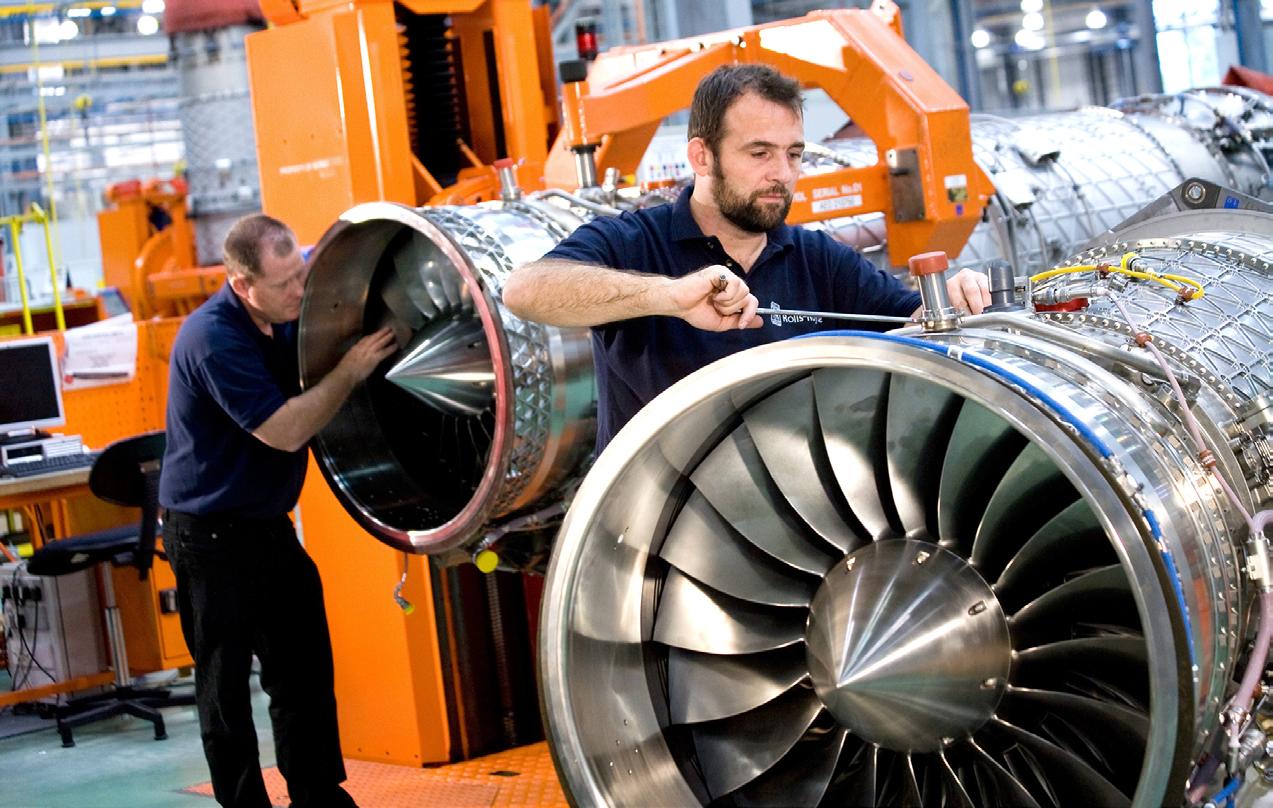
As part of their continued drive to enhance inclusion, the organisation’s Defence Division will offer a STEM Returners programme at their site near Bristol where candidates will be involved in projects including Tempest, which is developing the next generation of fighter jets; and Orpheus, a project developing efficient low burn engines. The skillsbased roles for returners will include opportunities in Engineering and Project Management.
STEM Returners, a leading organisation in the UK in returner programmes, will source candidates and provide them with additional support including advice, career coaching, and mentoring; ensuring applicants are ready and confident to return to work.
Annual research from STEM Returners (The STEM Returners Index) shows the challenges people who have had career break face, when trying to return – recruitment bias being the main barrier to entry. Sixty-six percent of STEM professionals on a career break say they are finding the process of attempting to return to work either
difficult or very difficult and that nearly half (46%) of participants said they felt bias because of a lack of recent experience.
STEM Returners has recently launched the 2023 STEM Returners Index, to understand STEM professionals’ experiences of trying to re-enter the sector after a career break. It is open to all STEM professions who have had a gap in their career, who are attempting to return to work or who have recently returned to work and asks a variety of questions including reasons for a career break and what challenges were faced when attempting to return to their profession. The survey will enable STEM Returners to further understand the barriers people face, track the progress UK STEM industries are making, and shine a light on the change needed to create fair opportunities for all. The 2023 STEM Returners Index will be open until 30 June 2023 and is available at https://online1.snapsurveys.com/ STEM-Returners-Index-2023
Since STEM Returners first launched in 2017, more than 310 STEM Returners candidates have joined programmes across the UK. To view STEM Returners opportunities, visit https://www.stemreturners.com/ placements/
41 Manufacturing & Production Engineering Magazine Latest News
This increase in workload for managers is negatively impacting their wellbeing and engagement, as well as overall company culture.
- Robert Ordever
your unused machine vision hardware doesn’t have to go to waste
In many plants you will find cameras, lighting and other hardware that was once part of a visual inspection system but is no longer fit for purpose. Do you have to rip it up and build from scratch? Here, Zohar Kantor, vice president of sales at visual inspection software company Lean AI explains why an equipment-agnostic software technology could can breath new life into your existing machine vision hardware.
It is estimated that between 2017 and 2020, approximately 270,000 machine vision systems were installed around the world. How many of these are still performing as they were intended to? It is impossible to know the exact figure, but this is a field where technology is moving very quickly. Solutions that were promised to be cutting-edge just a couple of years ago quickly become unsuitable.

A common issue is the lack of interoperability between different hardware components, or between hardware and software. Some software
solutions are vendor-specific, requiring you to buy new cameras and other sensors to get the best out of the latest artificial intelligence solutions. You face the problem that economists refer to as ‘‘sunk costs.’’ You have already invested considerable money in your machine vision equipment, so do you really want to rip it out and start again?
Retrofit and rejuvenate
Quality managers and plant managers are unfortunately not fully aware that there is an alternative solution in retrofitting. If a software solution is equipment-agnostic, meaning it is designed to operate with hardware from different vendors rather than being exclusive to one, you can bring new capacity to old investments.
If your existing image acquisition equipment is perfectly okay in terms of image quality and illumination, then the software was the problem. Why not leverage your existing hardware by finding a software solution that will work in tandem with it? We are currently putting this theory into
practice with a leading powder metal company in Canada. Lean AI’s artificial intelligence algorithms are designed to work with any hardware, so we can make use of cameras and computer hardware already in the plant, removing the need for the customer to rip this out and start again. Retrofitting in this way saves time, money and risk.
If only a small fraction of the 270,000 machine vision systems installed between 2017 and 2020 are no longer performing the tasks they were intended to then there is a huge opportunity to retrofit an equipmentagnostic software technology to breathe new life into your existing hardware. This is a problem in any industry where technological progress is flourishing, but with Lean AI’s software, you may not need to replace your hardware as soon as you think.
Lean AI uses patented deep learning algorithms to automate the process of building an AI inspection model for your production line.
Discover more at lean-ai-tech.com
Machining & Machinery 42 Manufacturing & Production Engineering Magazine
the benefits of legacy equipment with an equipment-agnostic solution
Why
Unlock
Pentagon, pro-actively supporting you from the early stages of design assistance right through to mould tool manufacture and repeat production of your injection moulding project. Your new or existing plastic injection moulding project will benefit from years of technical moulding experience!

DESIGN DEVELOPMENT MOULDING TOOLING BEYOND THE MOULD
UK Manufacturing services delivering ease of communication and a smooth supply chain www.pentagonplastics.co.uk | websales@pentagonplastics.co.uk Tel: +44 (0) 1403 264 397 |
Schaeffler supplies first customers with fully electric wheel hub motors
New drive technology accelerates electrification of municipal utility vehicles and enables new vehicle architectures.
With electrification, good things come in threes it seems. No less than three manufacturers of compact municipal vehicles are gearing up to incorporate high-efficiency electric wheel hub motors made by Schaeffler into their production lines in the coming months. Fully electrified, their road sweepers, vans and snowplough vehicles will operate with zero local CO2 emissions, leading to improved air quality in urban areas. “Schaeffler is reinventing the drive systems used in small, lightweight electric utility vehicles in our inner cities,” said Matthias Zink, Schaeffler’s CEO Automotive Technologies.
The defining feature of the new wheel hub motors is that all the components needed for propulsion and braking are integrated directly into the wheel rim, rather than being positioned centrally or mounted on the drive axles. This architecture saves space and makes the vehicles much more agile and maneuverable in city traffic. Utility vehicles powered by these low-noise, fully electric motors are very quiet to operate, resulting in reduced sound pollution in pedestrian areas and on city streets. They can also be operated for extended hours in residential areas because the disturbance to residents is so much less.
One of the first companies to be launching a multi-function vehicle
comprising Schaeffler wheel hub motor technology onto the market this year is Jungo. Jungo and Schaeffler have been partnering to tailor the drive technology to the specific everyday requirements of commercial street sweeping. “The electric in-wheel motors and braking technology eliminates the need for oil changes and greatly enhances our vehicles’ performance in terms of efficiency, power-to-weight ratio, safety, handling and braking reliability,” said Jungo founder and CEO Nicolas Jungo.
This new drive technology opens up a new and steadily growing market for Schaeffler. The company aims to see its wheel hub motors used in more and more utility and service vehicles in towns and cities, on factory campuses, and at logistics centres, ports, airports and large parking facilities. These types of vehicles tend to be operated on set routes, so they are a good fit for the fixed ranges and predictable charging times of electric drives. Another key benefit for vehicle operators is that the wheel hub motors have long-life, low-maintenance wheel bearings and gearboxes.
Schaeffler is reinventing the drive systems used in small, lightweight electric utility vehicles in our inner cities.

JLT Mobile Computers targets the port, manufacturing, and warehousing segments with upgraded JLT6012™ computer

JLT Mobile Computers, a leading developer of reliable computing solutions for demanding environments, has upgraded its powerful and versatile JLT6012 rugged vehicle-mount terminals (VMTs).
Originally developed for demanding warehouse and logistics applications that require IT solutions running Windows OS, the JLT6012 VMTs have proven to be a reliable computer platform in some of the world’s most challenging physical and environmental applications. The upgrades now take the rugged computers’ arena of operation into further industries, including container ports, yards, and manufacturing plants.
A result of JLT’s extensive and ongoing research and development efforts, the upgrade significantly enhances the popular JLT6012 VMT, showcasing what sixth-generation JLT devices will offer from this year onwards. This not only sees improved operational performance, the key to making the devices more suitable for a wider array of outdoor applications, but also the user’s ability to integrate them into Industry 4.0 information architectures, as many of JLT’s customers undergo digital transformation.
The new JLT6012 VMT comes with WWAN/4G and has been prepared for WWAN/5G to enable customers that do not have access to WiFi wireless networks to be connected, for example when using the devices in large port yards. Compared to the previous unit, the new JLT6012 VMT has improved performance with a more powerful CPU, in the shape of the Intel Elkhart Lake processor, coupled to more RAM. Network performance is also improved, with a new chipset that offers WiFi 6E capabilities and Bluetooth 5.2. Audio capabilities have been modified too. For more information about JLT Mobile Computers, its products, and solutions, visit jltmobile.com.
Product News 44 Manufacturing & Production Engineering Magazine
SUMO processing system offers big benefits thanks to YASKAWA MOTOMAN GP7 Robot

A new robotic handling system has proved to be very successful on an automatic grinding machine for a major German pump manufacturer who specialise in supplying customised pumps for automotive engineering applications.
At the heart of the automated system is a MOTOMAN GP7 one of the most successful robots developed by Motion control and robotics specialists YASKAWA. The GP7 is an extremely agile and compact universal robot with a 7kg payload, up to 927mm reach and outstanding repeatability of +/- 0.01mm.
Scherzinger Pumpen was looking for a suitable automation solutions partner to help them achieve their aim of gradually increasing the level of automation in their production processes. EGS Automation, located close by in the Black Forest, offered the necessary expertise with a
portfolio of robotic based automated systems dating back to 1999, involving the installation of over 2,000 robots. For this automated processing application the EGS SUMO series was ideally suited to meet the requirements, specifically the SUMO Multiplex a 12-fold production system based on the ‘paternoster principle’ - proved to be the best option.
Component handling is performed by the compact, 6-axis jointed-arm MOTOMAN GP7 robot which is attached to the system, delivering a fast travel speed and high accuracy to ensure rapid, reliable and accurate part changes in the processing machine.
The system incorporates an innovative side-shifting device which allows the entire unit to be shifted on its side in seconds, giving full access to the grinder.
The system can also be quickly pushed back in front of the machine and
From F5 to F6: how to switch to the new drive controllers
The COMBIVERT F5 drive controllers have been proven for many years when it comes to openloop and closed-loop applications in mechanical engineering. The new KEB drive controller generation – COMBIVERT F6 and S6 – opens up new possibilities and potential for users to increase the efficiency of machines and systems. But how is the switch from F5 to the F6 achieved and what should be considered?
The requirements in machine and plant design continue to evolve – and so does drive technology. Against this background, KEB Automation has introduced the COMBIVERT F6 drive controller as successor of the COMBIVERT F5. In numerous applications around the world, the all-in-one drive controller ensures maximum efficiency.

With a more compact design and a correspondingly optimised power density, as well as improved cooling concepts, the COMBIVERT F6 has features that take into account the changing demands of mechanical
engineering and machine design and build. Further advantages are offered in daily practice by the use of modern bus systems and the possibilities of encoderless safety, which reduces wiring effort and costs. And last but not least, a wide variety of motor technologies can be controlled with the COMBIVERT F6. Regardless of whether the motor is asynchronous, synchronous, synchronous reluctance, IPM linear or high speed, it is possible to switch to the respective motor via software.
Switching from F5 to F6 More and more users are turning to the new generation of drive controllers from KEB. The staff in KEB’s service department provided support in the actual implementation of the change from the F5 to the F6. As Niels Haase, Service Support Coordinator at KEB comments: “It doesn’t matter whether the request is for a new series of machine or for existing machines. In an initial discussion by phone or on the customer’s site, we record the requirements that the drive controller must fulfill in the application.”
precisely indexed so that it can swiftly resume automatic operation.
More at: https://www.yaskawa. eu.com/products/robots/handlingmounting/productdetail/product/ gp7_692
These requirements include both mechanical and electrical aspects. In addition, the environmental conditions in which the machines and systems are used, acceptances and approvals, as well as the desired software and hardware functions also play a central roles in the joint discussion of the requirements for use of the drives. “For better planning, we define a start and planned end of the customer project for each conversion of the drive controllers.
“When designing the drives, we use simulation methods such as hardware in the loop, which often shortens the time required for the changeover,” says Haase. “Apart from this, adapter solutions are also possible. When adapting from the F5 to the F6, the focus is then primarily on the pin assignment of encoders.”
For more information, please visit www.keb.co.uk
45 Manufacturing & Production Engineering Magazine Product News
Interview: Nadeem Gabbani
Manufacturing & Production Engineering Magazine speaks with Nadeem Gabbani, Founder of Exobotics about the creation of the new Department of Science, Innovation and Technology
Firstly, could you please tell us more about your company Exobotics?
Exobotics is a satellite development company offering nano-satellite testing and manufacturing, acting as an in-house satellite development team for customers both outside of the space industry in areas such as fintech, mining, agriculture, telecoms and beyond, and those within the industry who don’t have the skills, resources and experience to execute certain missions – making space accessible for all. The company has offices and labs based in London, Cambridge and Cornwall.
We oversee the end-to-end process of designing, manufacturing and testing nano-satellite systems in under 12 months through our fast-track programme, bringing to
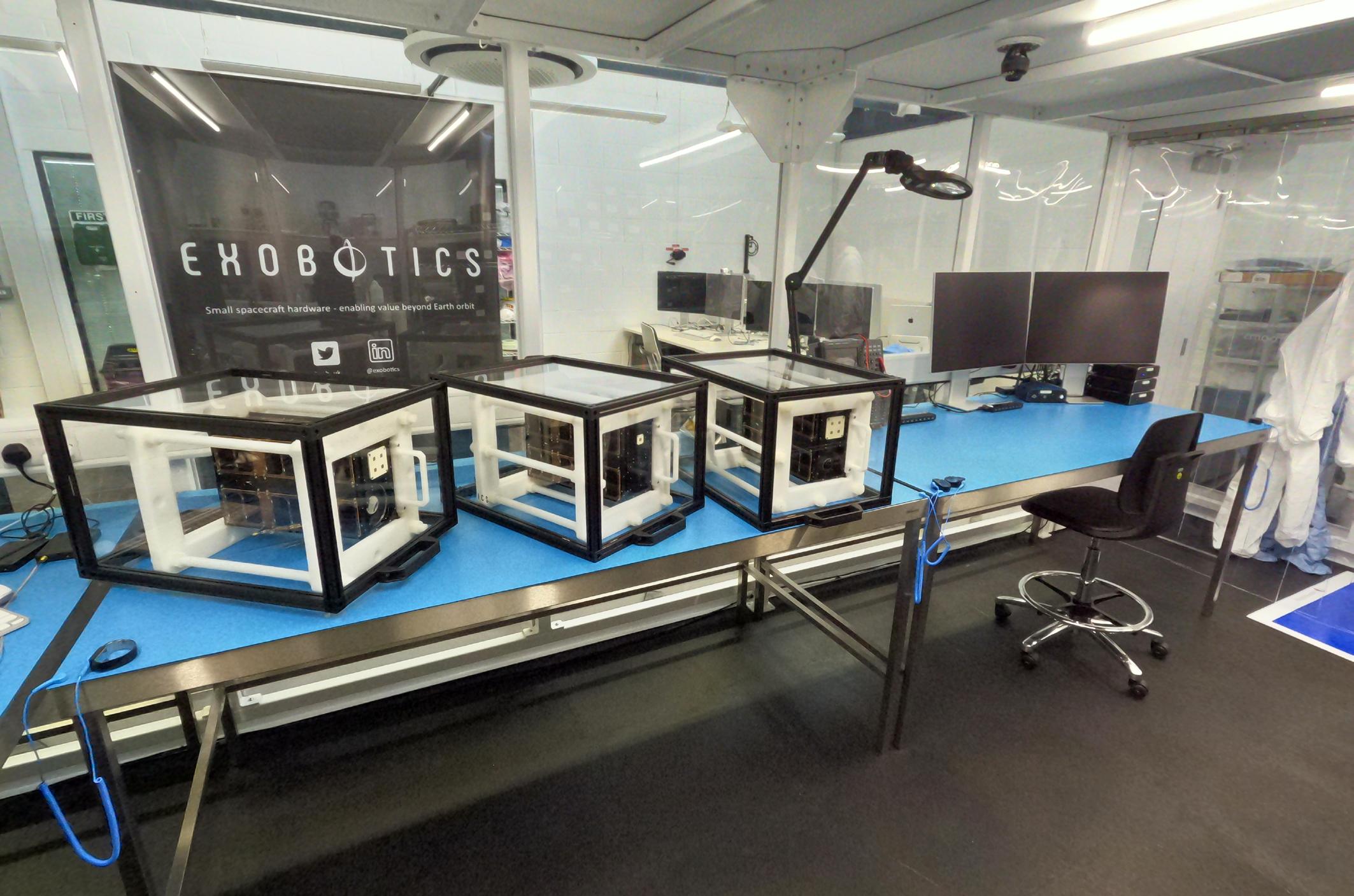
life a wide variety of briefs to life from bespoke payloads to satellite systems, from small CubeSats to 50kg microsatellites. Exobotics also offers satellite and testing products such as XO-BUS, payload agnostic nanosatellite platforms, and XO-VAC, a desktop thermal vacuum chamber.
What does the creation of the new Department of Science, Innovation and Technology mean for the industry?
The new Department represents an opportunity to streamline resources and initiatives from investment to education to shared technologies to better support industries such as space and manufacturing.
One of the key points in the Department’s formation is the creation of new high skilled jobs across the
country, and with a prevalent technical skills gap, DSIT should play a role in developing digital and technical skills to both train new staff and upskill existing workers who can transition into careers in STEM. Sectors such as space are rapidly growing and
46 Manufacturing & Production Engineering Magazine
Interview
Exobotics is currently working on a number of contracts for space missions for clients with fintech, mining and agriculture applications.
- Nadeem Gabbani
will continue to require new waves of highly skilled staff.
Do you think that this will develop and encourage UK innovation?
The Department’s Secretary of State, Michelle Donelan, being given a Cabinet seat is an encouraging move, indicating that innovation will be central to nation economic and growth plans with the government
already highlighting technologies such as semiconductors and telecoms as high potential. This should promote companies to invest, research and develop in these focus areas and drive innovations which can provide benefits across industries.
As DSIT begins pushing out new initiatives and programmes, the hope is that they will invest in and provide support for new start-ups and SMEs in the sector to help fuel their
growth, which will ultimately drive the economy.
In your opinion, how will the space industry particularly benefit from this?
The space sector can benefit from the planned job creation brought about by DSIT to populate the exciting array of new start-ups and SMEs leading innovation. Areas such as Earth Observation and In-Orbit Services and Manufacturing will continue to evolve over the coming years and developments may well be led by new staff entering the industry. Space provides an opportunity for huge growth nationally and regionally so stands to benefit from any major initiatives introduced by DSIT.
What are you currently working on?

Exobotics is currently working on a number of contracts for space missions for clients with fintech, mining and agriculture applications. This involves designing, manufacturing and testing nano-satellite systems and payloads ahead of planned launches through our fast-track programme.


What are your plans for Exobotics for 2023?
Exobotics is planning to launch several satellites for our clients in 2023, bringing the benefits of space to those outside of the industry. We want to keep providing value for our customer’s customers, solving core needs using innovative space solutions that can be scaled.
Over the next 12 months, we plan to continue raising the awareness of the benefits that space can bring and continue delivering on missions for existing and new customers operating outside of the space industry.
47 Manufacturing & Production Engineering Magazine Interview
Facilitating a Circular Economy through Sustainable Packaging: Material Selection, Carbon Reduction, and the Impact of Legislative Measures
The growing emphasis on sustainability in nearly all sectors has placed the packaging industry under scrutiny. As a critical component of the global economy, the packaging sector holds significant environmental implications. In the pursuit of sustainable packaging, a holistic approach is necessary, encompassing aspects such as material selection, carbon footprint reduction, and the development and implementation of government policies that foster a circular economy. This article provides a comprehensive examination of the key themes and challenges surrounding packaging and recyclability and delves into their connections with prevailing environmental concerns and policies.


The three main elements of environmentally sustainable packaging are Resource Planning, Carbon Reduction, and Waste Reduction. Resource planning aims to cut waste by encouraging reusability through material choices which facilitate reuse and efficient recycling. Carbon Reduction strives to lower the impact of greenhouse gas emissions by considering the entire carbon lifecycle of packaging, from manufacturing to consumer behaviour. Grasping an understanding of the stages in the lifecycle with the largest carbon emissions enables those areas to be addressed through the initiation of programmes such as utilising renewable energy for production or enhancing transportability through alterations in packaging dimensions or form. Waste Reduction aims to lower waste volume through strategies like waste prevention, reuse, recycling, and composting. This can be achieved through material minimisation, recyclable or compostable designs,
and reusable packaging systems. Using alternative packaging materials, such as recycled paper, biodegradable polymers, and plant-based options, can also decrease the carbon footprint of packaging.
One method to advance sustainable packaging solutions is through the establishment of regulations and policies that inform decision-making among businesses. Making the environmental impact of a diverse array of materials and products transparent can encourage manufacturers to choose more sustainable options. Environmental Product Declarations (EPDs), for instance, can provide valuable data for comparisons. Nevertheless, the current EPD system contains technical documentation that is difficult to evaluate, whilst there is a shortage of available EPDs. To tackle this problem, it is critical to make these evaluations more accessible to the general public.
There is also a need for more sophisticated guidance in evaluating the emissions associated with different disposal techniques.
48 Manufacturing & Production Engineering Magazine
Packaging
Nathan D. Wood, Dr Aaron Yeardley, Natalie Bavis, Dr Torill Bigg
The three main elements of environmentally sustainable packaging are Resource Planning, Carbon Reduction, and Waste Reduction.
Dr Aaron Yeardley
Dr Torill Bigg
Presently, the emission factors provided by the UK Department for Business, Energy & Industrial Strategy inadvertently provide incentive for organisations to prefer landfill disposal of plastic rather than recycling. To address this issue, an effective strategy should focus on pinpointing opportunities to decrease carbon emissions specifically from recycling processes themselves. This may encompass investments in cutting-edge recycling technologies, enhancement of sorting and separation procedures, and the investigation of pioneering recycling methodologies for a diverse array of materials.
Besides transparency on the environmental impact of materials, incentives and regulatory measures play a vital role in promoting sustainability. The UK, for example, has taken a leading role in implementing environmental policies such as the ban on plastic microbeads and limitations on single-use plastic items. These policies are important in addressing both the impact on resource use and environmental plastic pollution. The implementation of policies encourages consumers and businesses to adopt sustainable alternatives.
Despite efforts to manage plastic waste recycling, a notable gap persists in the UK between recycling rates of paper/cardboard (71%) and plastic packaging (44.1%). To address this, the UK government introduced a tax in 2022 targeting plastic packaging with less than 30% recycled content. This strategic tax measure is designed to provide businesses with an economic incentive to incorporate recycled plastic materials into their packaging, thereby fostering increased waste plastic recycling and collection rates, and ultimately reducing waste destined for landfill or incineration. The tax is projected to increase recycled plastic utilisation by 40% and result in carbon savings of nearly 200,000 tonnes during 2022-2023.
Furthermore, in light of the pressing demand for enhancing the recyclability of packaging materials, the UK Government has introduced the concept of ‘Extended Producer Responsibility’ (EPR). As of January 2023, businesses have been mandated to collate data pertaining to their packaging to comply with EPR regulations, with a registration deadline of 2024, at which point fees shall become payable to the environmental regulator. By holding packaging manufacturers responsible for non-recyclable materials, EPR is anticipated to lead to a shift towards reusable or recyclable materials, thus fostering a circular economy.

It is imperative to create informed and balanced policies in order to circumvent potential pitfalls while meeting sustainability objectives and goals. Certain measures may inadvertently encourage bad behaviours, such as an increase in landfill disposal to reduce the measured carbon footprint of companies who conduct yearly carbon assessments. Policymakers must carefully evaluate the potential consequences of their actions to ensure that they do not result in counterproductive outcomes. Another challenge is the potential for ‘greenwashing’ or the practice of making misleading claims about the environmental benefits of a product or service. Policymakers and industries must remain vigilant against greenwashing and promote transparency.

49 Manufacturing & Production Engineering Magazine
Packaging
Despite efforts to manage plastic waste recycling, a notable gap persists in the UK between recycling rates of paper/cardboard (71%) and plastic packaging (44.1%). To address this, the UK government introduced a tax in 2022 targeting plastic packaging with less than 30% recycled content.
Natalie Bavis
Nathan D. Wood
Protolabs’ unveils advanced capabilities and volume pricing through unique manufacturing model
The world’s leading digital manufacturer has invested in a new manufacturing model that will help its growing customer base access advanced production capabilities, reduced part costs and, importantly, higher volumes.
Protolabs has combined its own, state-of-the-art digital factories in the UK and Europe with a distributed network of manufacturers that is powered by Hubs, transforming the way production at all volumes can be achieved quickly and to the highest quality.
Customers across aerospace, automotive, construction, medical and renewables can benefit from the new capabilities across CNC machining, injection moulding, and 3D printing services by tapping into the digital network.

This complements the low-volume, on-demand manufacturing services already available from Protolabs sites in Telford in the UK and Putzbrunn in Germany.

With volume pricing options, customers can lower their overall piece-
part price as quantity increases for machined and moulded parts. The new manufacturing model provides:
• CNC machining: Tolerances down to ±0.020 mm are available, as is decorative and hard anodising, surface treatment (black oxide, nickel, painting, chromate coating) and larger quantities. Parts as large as two meters (2000mm x 1500mm x 200mm) and as small as 0.5mm are also supported.
• Injection moulding: Demanding moulding projects, in need of larger, deeper parts (1200 mm x 700 mm x 300 mm) and more complex parts, are also catered for.
• 3D printing: Fused deposition modelling (FDM) 3D printing is now available via the network for rapid prototyping of cost-efficient parts. This is in addition to Protolabs’ six other plastic and metal additive manufacturing technologies offered through its digital factories.
All of the enhanced manufacturing capabilities are now live and available to
New Initiative Equips Teachers for 3D Printing and Scanning
Daemon3D Print is launching a new initiative that equips and supports teachers to deliver highly effective lessons on how to use and apply 3D printers and scanners. It is aimed at both STEM and arts subject specialists for key stages 3 and 4.
This is part of the company’s Makerspace services, which have been developed to provide curriculum support in the use of state-of-the-art equipment including 3D printers, laser cutters, 3D scanners, robotics, and supporting technologies and skills.
Daemon3D Print offers inspirational lesson plans and story-based course materials for schools to help teachers
generate interest and understanding in these key technologies. The aim is to not only support your Makerspace ‘space’ but also your Makerspace usage.
Makerspaces help teachers create and deliver engaging learning experiences so students of all abilities can find their strengths and realise their potential. Working individually or in teams, students are able to constantly motivate and support each other in their individual tasks and learning.

Students’ creativity is put to the test when they are asked to design solutions to real-world challenges and are often asked to research and write about their creations. The educational possibilities that come with the ability to bring any idea to life in the classroom are endless.
The state-of-the-art makerspace course materials can prepare students in KS3 and KS4 to develop the skills needed to take the next steps in their studies. These skills are ultimately prized by employers within industry 4.0 and the world of work generally.
customers, who can access the new CNC machining and 3D printing capabilities through protolabs.com, and expanded injection moulding options directly through hubs.com
Mr. Fayokun, an Engineering Lecturer at Croydon College said: “We have noticed a significant difference in the mindset and abilities of student applicants from schools who have integrated makerspace technology and concepts within their curricula at key stages 3 and 4.”
The late Nicola Stokes, who as Director at Daemon3D was instrumental in developing this new initiative, added: “Too many schools are left unsupported with their makerspace technologies such as 3D printers, laser cutters and, scanners, meaning expensive kit is often left to gather dust in a corner.”
“As part of our Makerspace service, we provide the technical support and educational tools needed for teachers to integrate their technology and deliver its full learning potential. We have seen this technology used by students in key stages 3 and 4, not just in STEM where you’d expect, but also in art and design. Teachers are using our Makerspace package to increase students’ motivation and engagement through the use of our captivating lesson plans and storytelling themes.”
For more information: https://www.daemon3dprint.com/ makerspace
Company News 50 Manufacturing & Production Engineering Magazine
Secure Transit Protection
PaintGuard™ is the new and secure way to send your tins and tubs of liquids through the post.







PaintGuard™ is suitable for a wide variety of goods within the decorating sector, including paint, varnishes and oils. PaintGuard™ is available to secure a range of container sizes and is available in single or double-pack carton options.


Manufactured using fully recycled materials and being fully recyclable, our pulp fitment range fits into specially designed cartons that can securely fit multiple sizes of metal tins/plastic tubs, providing functional, affordable transit packaging protection.



to visit the full PaintGuard™ range
























www.allpack.uk.com sales@allpack.uk.com 01543 396 700
Protects against in-transit spills. 100% Recyclable Supplied by
Scan me









 Paul Attwood Editor
Paul Attwood Editor








































































































































































